Planeswalker's Guide to Aetherdrift, Part 2
The Ghirapur Grand Prix is approaching, and Aetherdrift is your chance to go for the gold in this race filled with multiversal mayhem. The Planeswalker's Guide to Aetherdrift is your guide to the planes, characters, and history of the set (read part one here). We'll be off to the races early next year when Aetherdrift's story starts on January 13, 2025, right here on DailyMTG. Audiobooks will also be made available on The Magic Story Podcast alongside the main stories, so you can enjoy the high-octane action however you like.
Aetherdrift releases on February 14, 2025, and is available for preorder now! You can preorder Play Boosters, Collector Boosters, Commander decks, and more at your local game store, online retailers like Amazon, and elsewhere Magic products are sold.
In Aetherdrift, we follow the events of the second interplanar edition of the Ghirapur Grand Prix across its three participating planes: Avishkar, Amonkhet, and Muraganda. While the race and the ten teams that participate in it are the focus of the set, we also want to spotlight the host planes.
In this section, we'll touch on the current state of Avishkar, Amonkhet, and Muraganda.
Avishkar
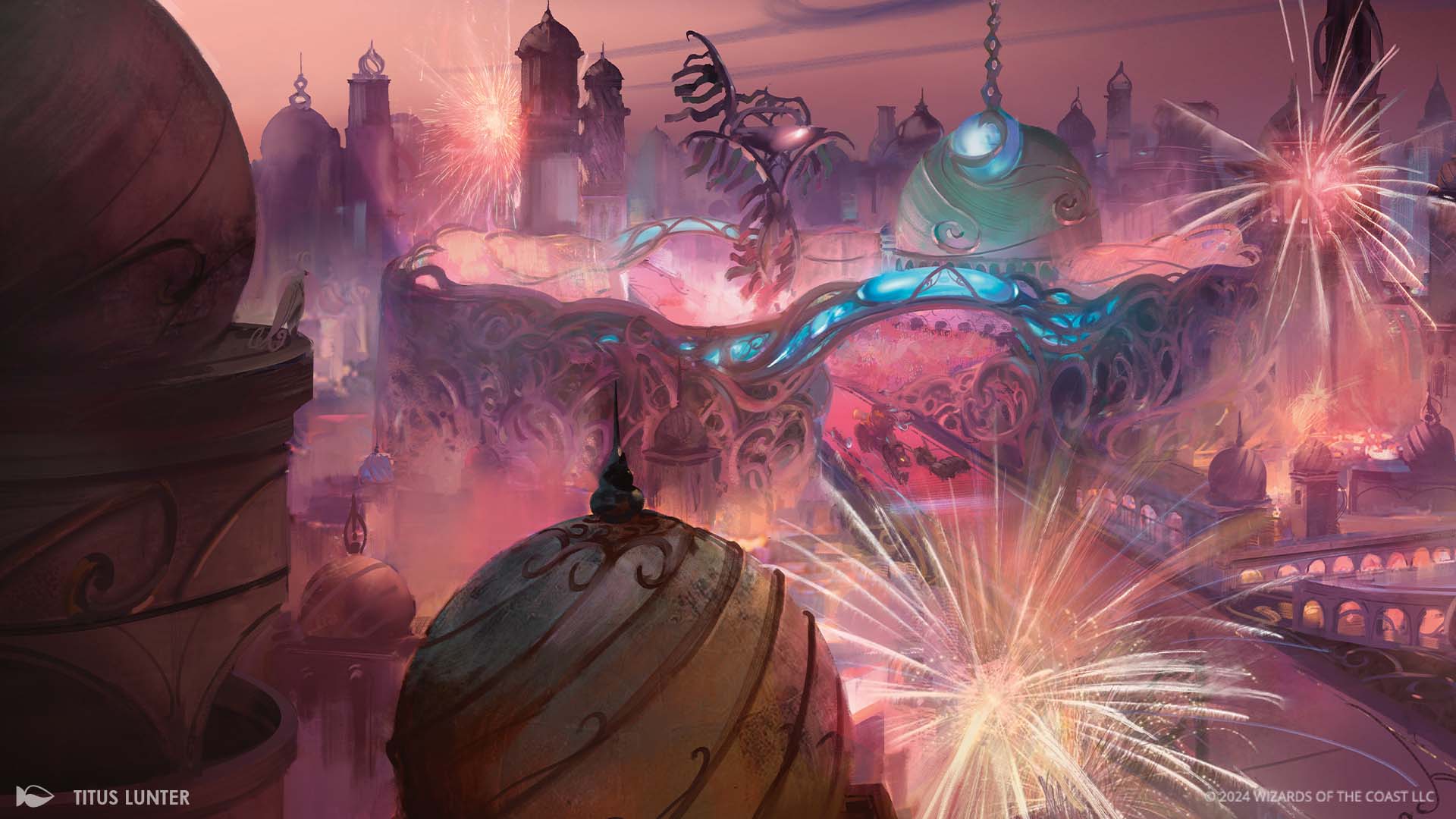
Avishkar, formerly Kaladesh, is a plane ascendant, its people united behind the banner of a popular revolution made real. The new planar government, the Avishkar Assembly, is a democratically elected body of representatives from the plane's eleven administrative districts. Their first act was a symbolic one: renaming the plane to slough off the rhetorical weight of the pre-Consulate monarchal era, the initial Consulate, and the post-Aether Revolt reformed Consulate. Bolstered by popular mobilizations across the districts, Avishkar—now administered by the Avishkar Assembly—has set its sights on reconstruction and multiversal hegemony.
The Phyrexian Invasion and Indigo Revolution
The reformed Consulate would last only long enough to steward an interregnum between the revolution and invasion. The Aether Revolt saw a popular but ideologically messy group—the Renegades—topple the tyrannical grand consul, replacing him and his Consulate with a reform-minded system with the same name. This reformed Consulate sought to revise much of the old Consulate's policies, laws, and practices with an eye toward equity. Avishkar's population initially welcomed this change but grew frustrated with the new government over time as the reformed Consulate proved only capable or willing to enact minor alterations to the status quo. Life, for most on Avishkar, did not change in the ways the Renegades had promised. Various elements within Avishkar rumbled their discontent as both reactionary and progressive columns began fresh agitations. However, before meaningful political opposition could manifest, the New Phyrexians launched their invasion of the Multiverse under the command of Elesh Norn.
The Phyrexian invasion did not defeat Avishkar, but it broke the Consulate's back. A compromised government since its inception, this iteration of the Consulate crumbled in the wake of the invasion, which saw Avishkar caught on the back foot after the Consulate ignored repeated warnings of imminent catastrophe. A defense of the Consulate would call attention to the state of the government after the Aether Revolt: the hamstrung legislative, judicial, and municipal systems burdened by a backlog post-Revolt; the restive remnant of the conservative, old Consulate still in government; and the Renegades' laissez-faire approach to planar governance beyond aether distribution policy were all contributing factors to the Consulate's inability to mount a planar defense. City and district-level mutual groups, criminal organizations, and more radical revolutionaries stepped into the vacuum, managing the chaos and fighting back against the Phyrexians. When the invasion ended, the victors would not accept a return to the norm. As one, they demanded the Consulate step down, and the surviving members obliged.
This was the Indigo Revolution: a largely bloodless and revolutionary transfer of power orchestrated by radical members of the reformed Consulate, partisan revolutionaries across Ghirapur organized under the New Culture Collective, along with various other labor, peasant, and student groups. Their grievances were many, but consensus coalesced around two major points. First was the reformed Consulate's failure to prepare for and address the Phyrexian invasion—a self-evident failure that touched nearly every inhabitant of Avishkar. The second concerned the distribution of aether across Avishkar, a system implemented under the rule of the old Consulate and not sufficiently changed by the reformed Consulate.
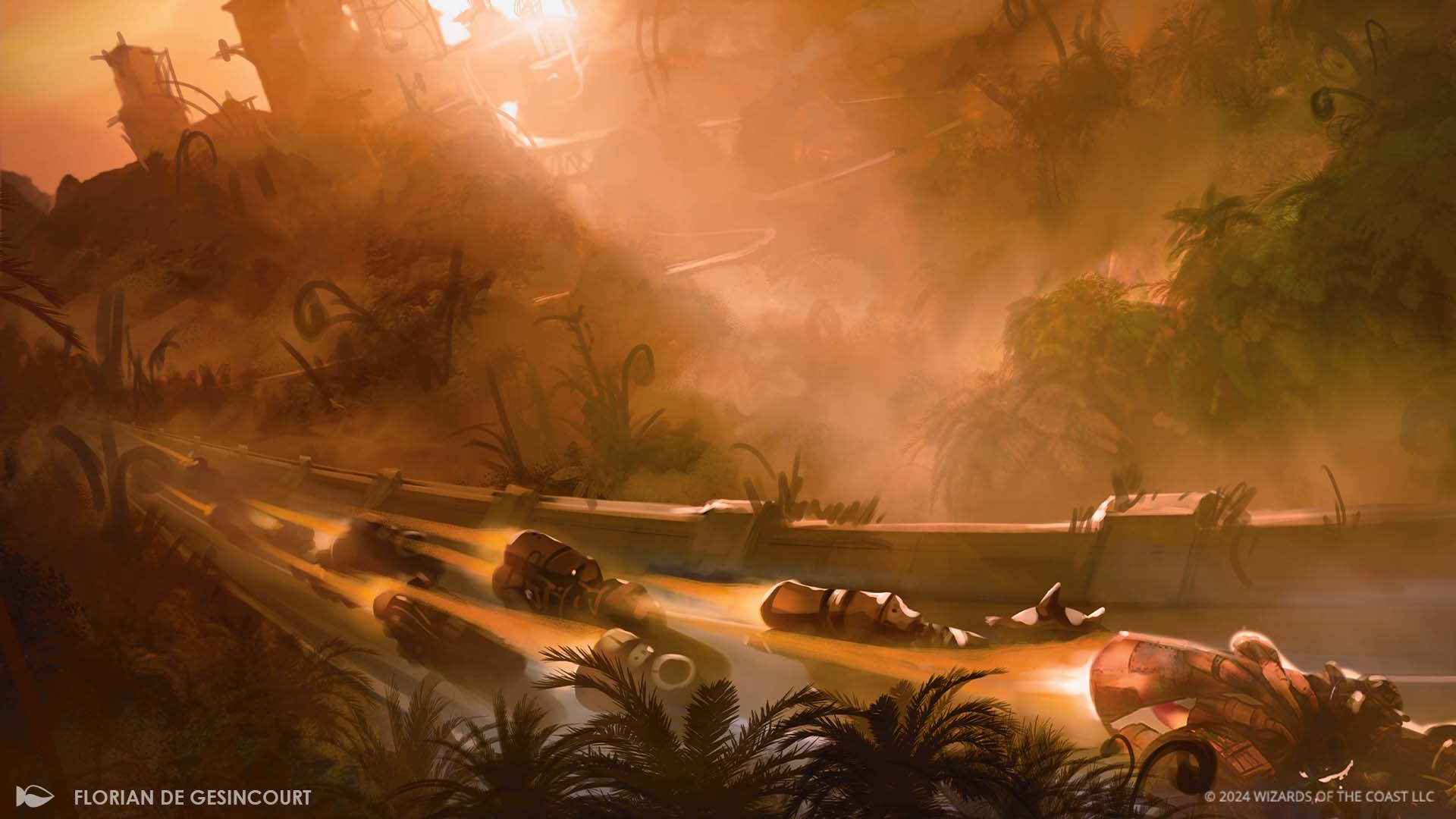
Under the old Consulate's administration, the laboring classes of Avishkar worked under a system of ratcheting aether quotas, pay bands, and strict distribution regulations. In theory, this system should have ensured a horizontal society of post-scarcity abundance enabled by aether's limitless free energy. In practice, the refinement and distribution of aether was artificially bottlenecked by the Consulate, whose hands-on regulation of the aether industry served to pad the accounts of the politically powerful. Instead of free and abundant distribution of energy, Avishkar labored under conditions of artificial scarcity. People who were poor were engineered to be poor by the economic system that dominated pre-invasion Avishkar. This system persisted after the Aether Revolt and the reformation of the Consulate. As many of the same functionaries, apparatchiks, and consuls remained in place following mere repudiations of the disgraced grand consul and the old Consulate. This fueled the protestations and frustrations of reform-minded and progressive consuls, chief among them Pia Nalaar, the former popular leader of the Renegades.
The Indigo Revolution, so named after the indigo color associated with these revolutionaries, took advantage of the chaos following the Phyrexian invasion, rallying the citizen defenders of Ghirapur and Avishkar to sweep aside the old government once and for all, replacing it with an assembly of elected officials drawn from Avishkar's eleven districts. This full-scale remaking of Avishkar's planar government (and subsequent renaming of the plane) was only possible given the epochal revelations of the Multiverse and the colossal failure of the Consulate system. History had offered the people of Avishkar the lead, and they took it. The survivors swept away the Consulate and established the Avishkar Assembly. Committed to their principals of representation, the new administrators have even allowed some surviving members of the reformed government to be elected to represent their districts. Despite this holdover, Avishkar's new government is composed almost entirely of new legislators. The task before them is colossal, but for the time being, they have a popular mandate to enact radical change in the name of progress.
The Avishkar Assembly
Avishkar's new leadership operates with a twin mandate in the post-invasion Multiverse: rebuild from the invasion and establish Avishkar as a hegemonic multiversal power, ensuring the plane is insulated from the dangers of the Multiverse by allies and soft-power defenses. To shed the caustic burden of the old Consulate and further reinforce their plane's new name, the new government calls itself the Avishkar Assembly, or just the Assembly.
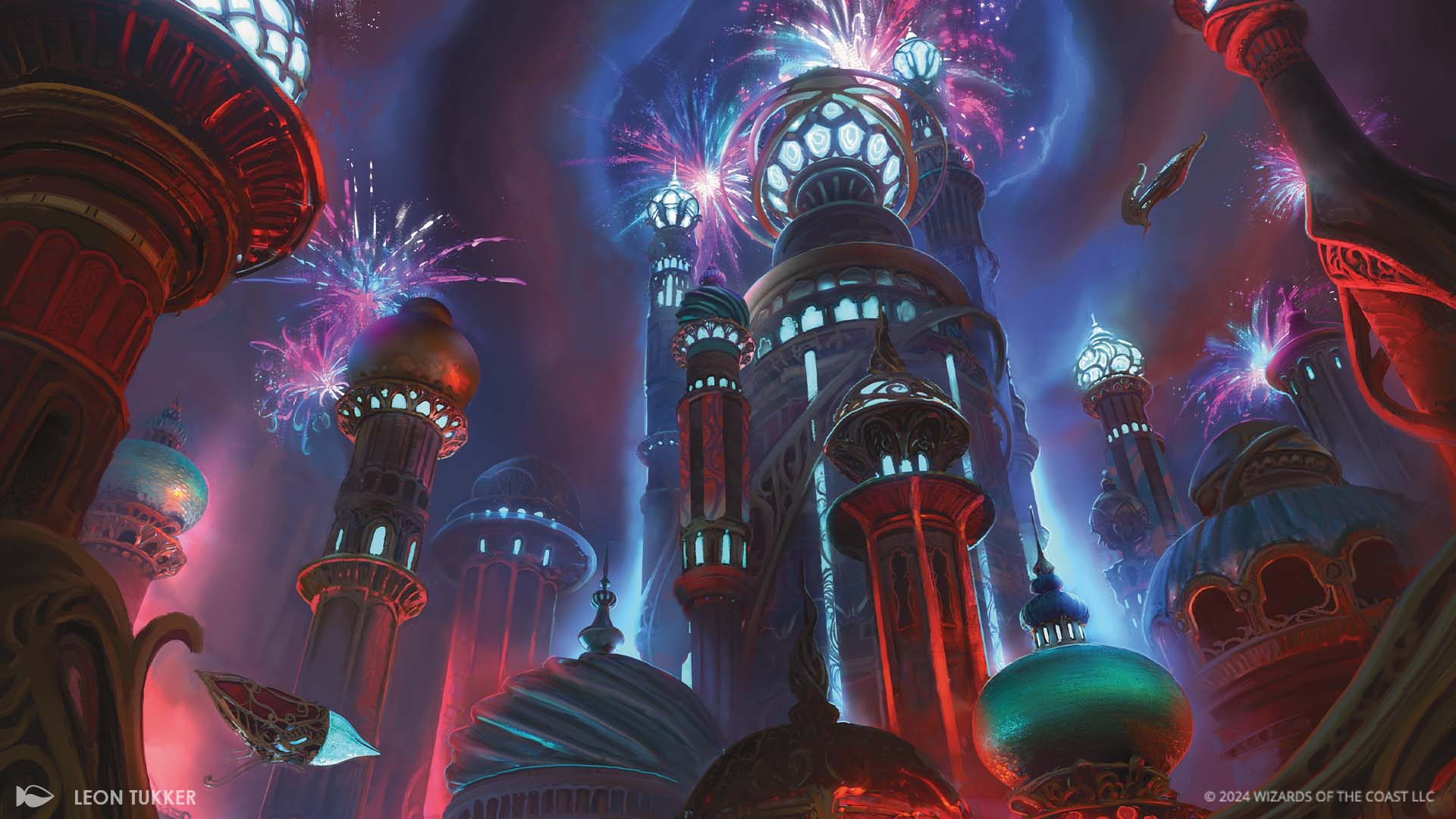
In the years after the Phyrexian invasion, Avishkar is one of a handful of planes whose governments have developed a conception of themselves in relation to other planes of the Multiverse and begun to implement that conception into their domestic and interplanar policies. Whatever their conception of politics and economics on Avishkar, the revolutionaries of the Avishkar Assembly are not naive to the threat poised to their newly won plane by the creatures and planes of the Multiverse; Omenpaths make the threats that once only stalked nightmares a reality. By commanding the paths of travel, establishing outposts and consulates across connected planes, and developing a knowledge of the Multiverse beyond the bounds of their homeworld, the Avishkar Assembly seeks to establish Avishkar as a known power abroad.
In this effort, Avishkar has come to recognize Ravnica as its chief rival. There are other planes—Dominaria, Zendikar—who have mighty factions on them but lack the same plane-wide administration. The Avishkar Assembly sees Ravnica, along with its guilds and their leader, Niv-Mizzet, not as an enemy (yet) but as the only plane that rivals their power on the multiversal stage. To that end, the Assembly maneuvers diplomatically and culturally to position themselves as the most attractive hegemon to the other planes of the Multiverse. Avishkari money, trade goods, luxury goods, and cultural exports flow into the planes of the Multiverse, carried by state missions, envoys, celebrities, and private concerns, and in return, trade and diplomatic partners are invited into Ghirapur and other special economic zones around the plane.
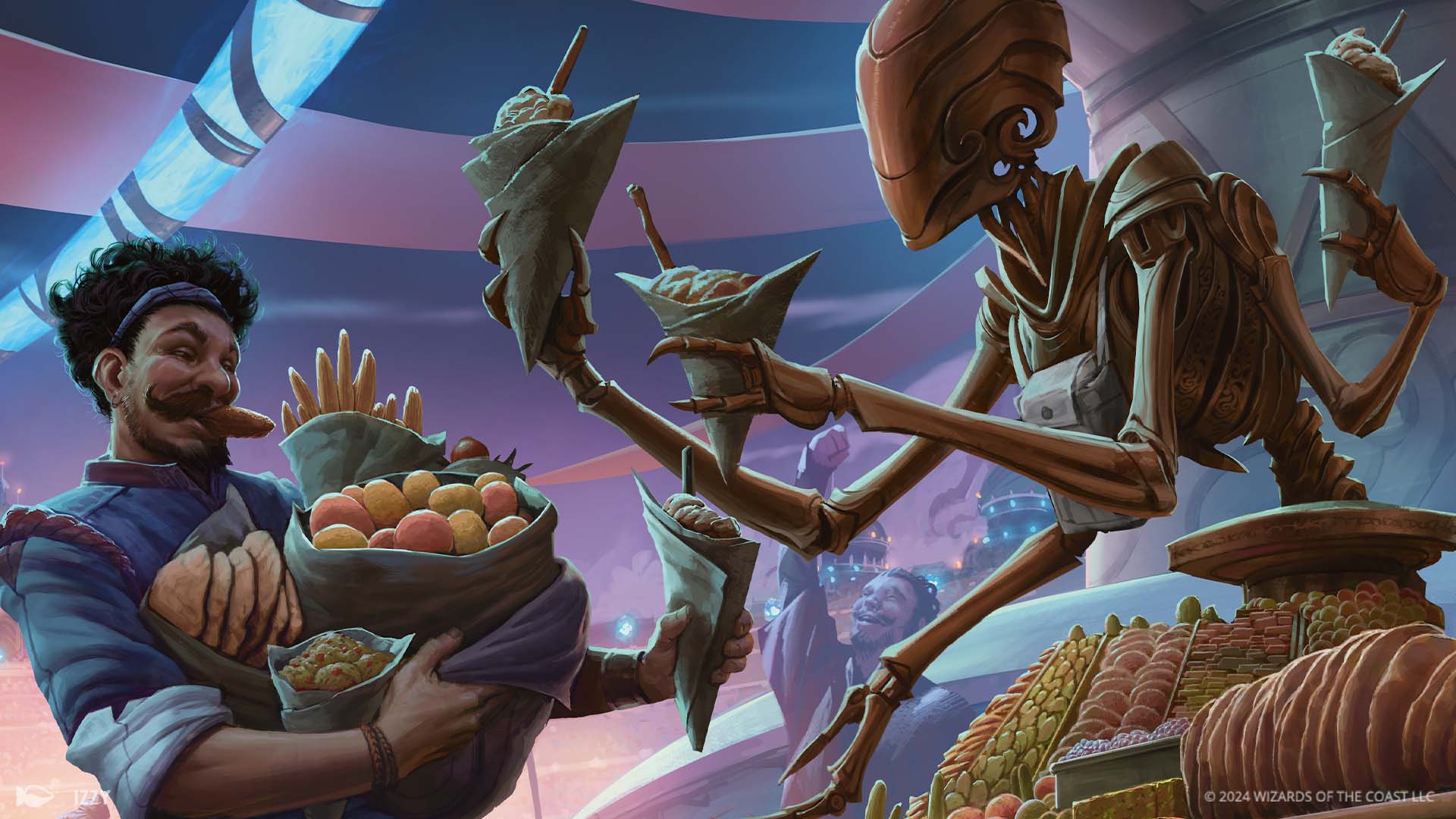
Following this ongoing soft-power campaign, the Avishkar Assembly has won the first victory of this new multiversal game of power: increasingly, the planes of the Multiverse use the Avishkari standard system of categorizing Omenpaths, learned from terminology employed by commentators, racers, and fans of the Ghirapur Grand Prix, alongside Avishkari standards of aether refinement and measurement. The GGP may be a prestigious sporting event to its fans and participants, but to the new government of Avishkar, it is far more. The GGP is not just a contest to see who can build and race the better vehicle but who can and should command the direction of the Multiverse.
Omenpath Classifications
The official Avishkari Omenpath Classification System is a simple, colloquial system that attempts to batch Omenpaths into three recognizable categories. This system isn't intended to be a technical classification system for industrial or academic use but a quick-reference system for popular use by peoples across the Multiverse.
Evergreen Omenpaths are stable Omenpaths that opened in the wake of the Phyrexian invasion and have not yet closed. Evergreen Omenpaths can be downgraded to deciduous or instanced. The major Omenpaths used by the Ghirapur Grand Prix (Avishkar-Amonkhet, Amonkhet-Muraganda, and Avishkar-Muraganda) are evergreen Omenpaths, continuously open since their first manifestation.
Deciduous Omenpaths are stable in that they open and close on regular, predictable cycles. Many deciduous Omenpaths open and close on Avishkar, connecting the plane to other planar "neighbors" (Avishkar-Alacria and Avishkar-Kylem, to name two).
Instanced Omenpaths are any other Omenpaths, including those that have recently opened and are undergoing evaluations to determine their stability and/or regularity. These Omenpaths are said to be "instanced," as the schedule that dictates their opening and closure is unique to that Omenpath. For example, the Avishkar-Duskmourn Omenpath opened for mere seconds, while the Avishkar-Gastal Omenpath opened for days. The Omenpaths that allowed the Speedbrood, Goblin Rocketeers, Guidelight Voyagers, and Keelhaulers into Avishkar are all other examples of instanced Omenpaths.
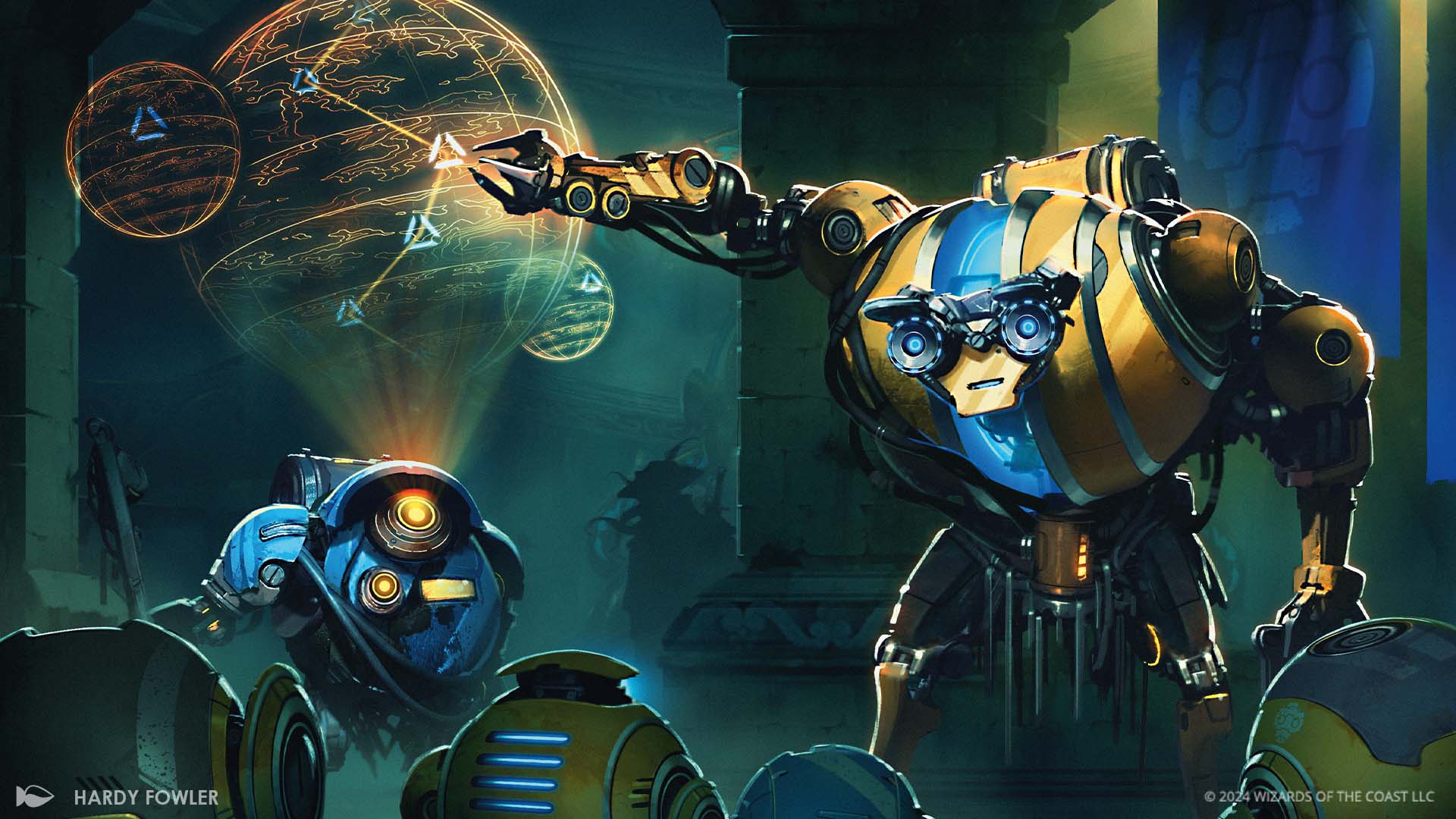
Amonkhet
The God-Pharaoh. The War of the Spark. The Phyrexian invasion. Amonkhet has long suffered the ravages of the Multiverse's worst devils and tyrants, so much that its own history has been all but lost to the oblivion of forgotten time. However, dawn approaches this wounded plane. The Amonkhet we encounter in Aetherdrift is an Amonkhet that, for the first time, is both aware of its history and truly in command of its destiny. It is with that hope—to take command over its own destiny—that, when the Omenpaths opened, Amonkhet welcomed delegates from Avishkar and chose to participate in the Ghirapur Grand Prix.
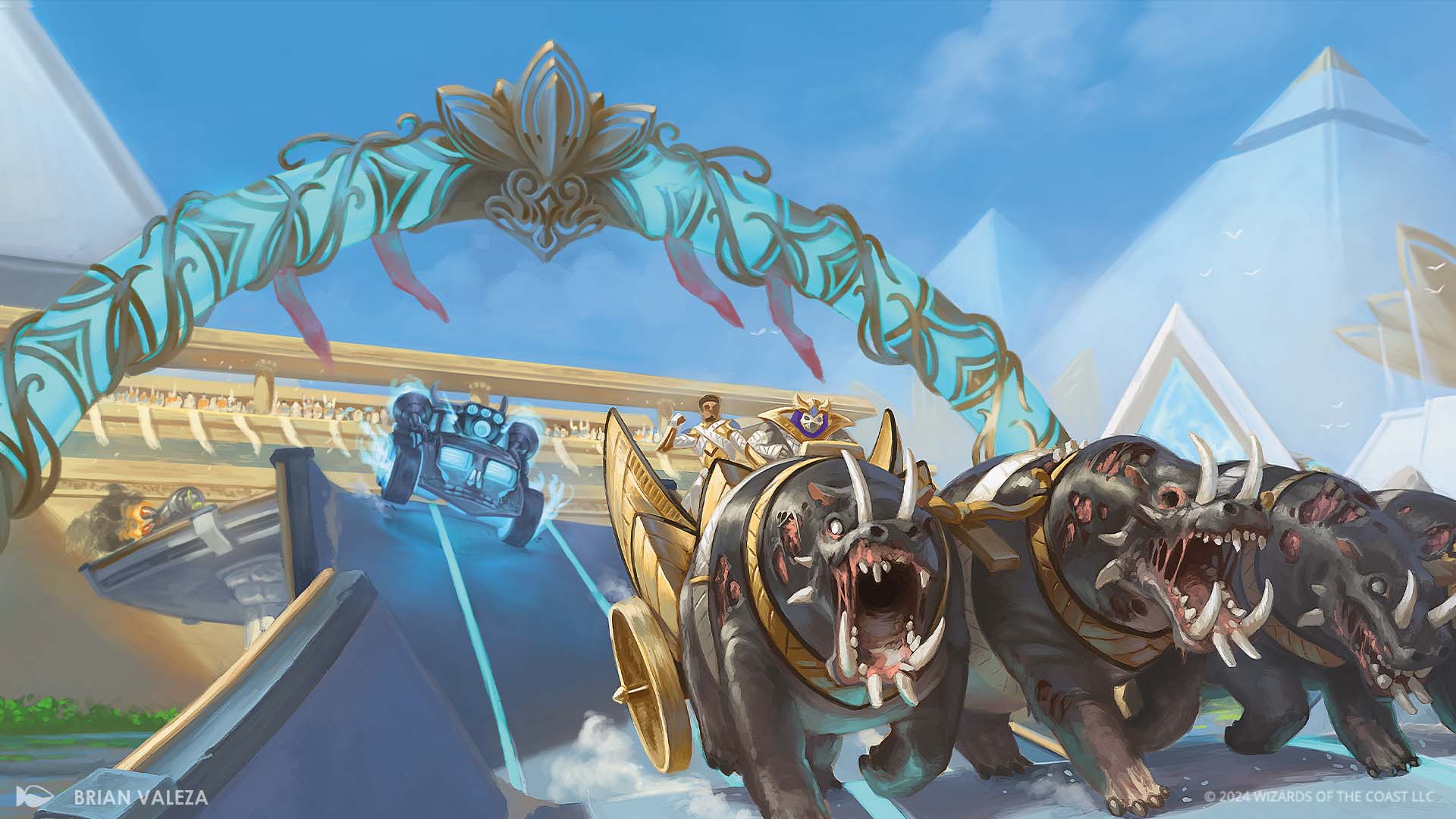
Amonkhet is eager to prove that it is not a plane in its twilight. Like Avishkar, Amonkhet stands eager at the break of dawn, bloodied but not defeated. To that end, the built course on Amonkhet will progress only over the ruins and structures that the leaders of Naktamun have allowed them to use. History's depth on this plane is fathomless, and there are monuments to rulers and gods who not even the most aged unliving recall. Paving them over with tracks and grandstands is no different than letting the sand swallow them. To the contrary, allowing Amonkhet and her people access to these lands could only benefit Amonkhet with trade and exchange of technologies. Amonkhet will allow the remote stages of the race to cross the Broken Lands as well. It is a good chance to probe the unknown quarters of their plane, to send life and fury out into those dry sandscapes and see what—if anything—responds.
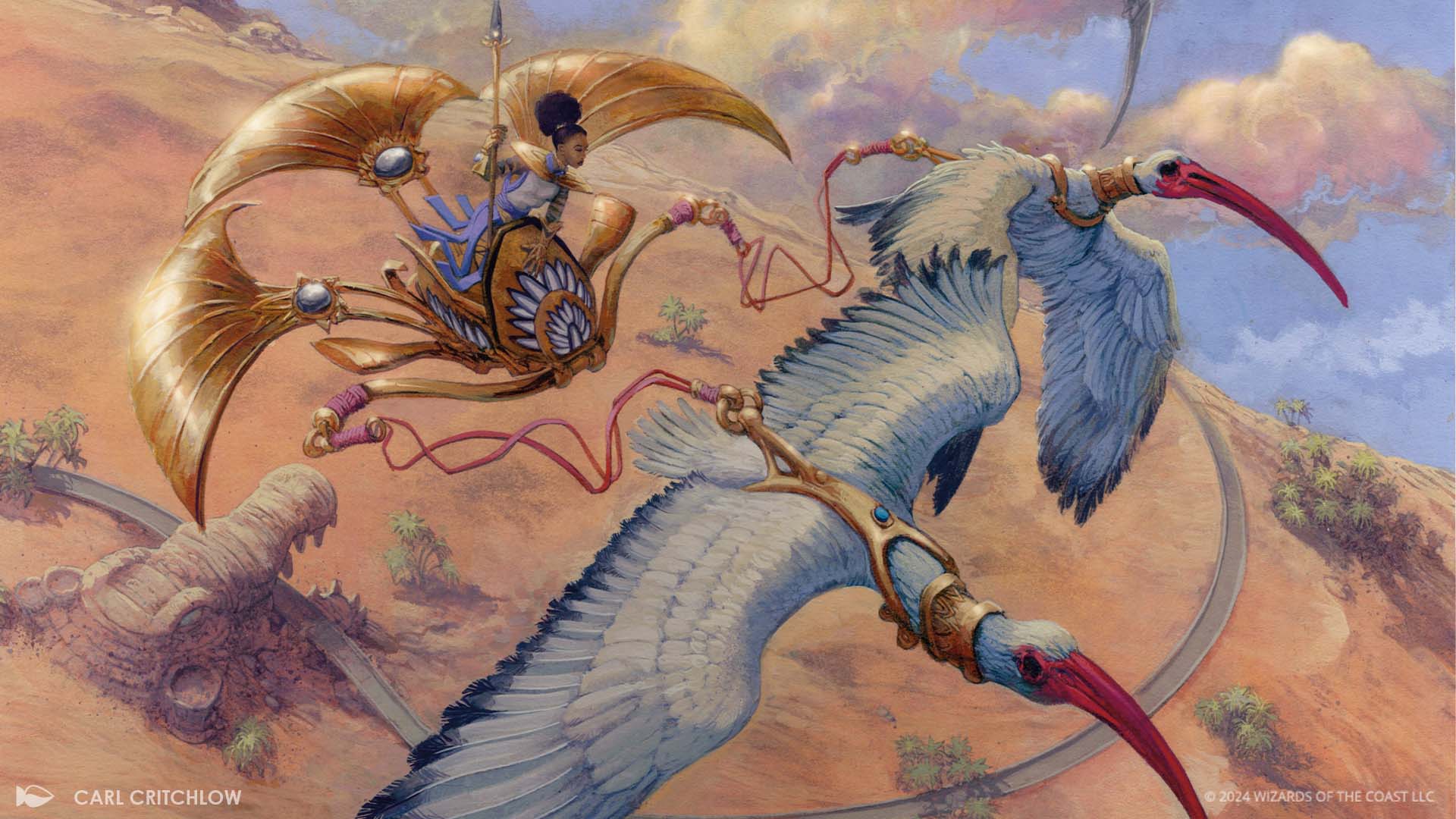
Moreover, Amonkhet has the honor of a team participating in the race. Champion Zahur and his retinue, along with the sparkless Planeswalker Basri Ket, represent the united hope of Amonkhet's living and dead. The crowds lining the route and packing the grandstands will be the Amonkheti, collected for the first time in a long time to celebrate, to cheer in hope rather than fear, and exult in the victory they are sure is to come.
Naktamun and the Luxa Purified
Prior to the events of Aetherdrift, the Phyrexian invasion raged across Amonkhet, centered on the city of Naktamun, the last redoubt of the living who survived Bolas's reign and the War of the Spark. As with other planes during that conflict, the existential threat presented by the Phyrexians forced former foes to work together through the days of the invasion, but no further. During the invasion, the deity Hazoret stood shoulder to shoulder with the Locust God and the Scarab God in Naktamun and marshaled a united force of the living and the dead to defend the plane. Their defense was successful despite the collapse of the Hekma.
With the Phyrexians defeated, the Amonkheti could declare victory. The Scarab God and Locust God retreated to the Broken Lands. Hazoret, alongside the living and loyal undead of Naktamun, chose not to pursue. Instead, she worked alongside the survivors in rebuilding the city. This was a colossal effort, one that employed both the living and the dead and, broadly, fell into two major tasks: defending the city from the wandering, lost undead of the Broken Lands following the collapse of the Hekma and beginning the great undertaking that is reconstruction. A hopeful sign followed the end of the invasion: the Luxa, fouled for so long, began to flow clear. The living rushed to the breached walls of Naktamun to hold back the steady but directionless tide of wandering undead. These poor, dangerous creatures were drawn to the city by the living, driven by the last echoes of their own fading souls to take the city for themselves. The living fought to hold them back.
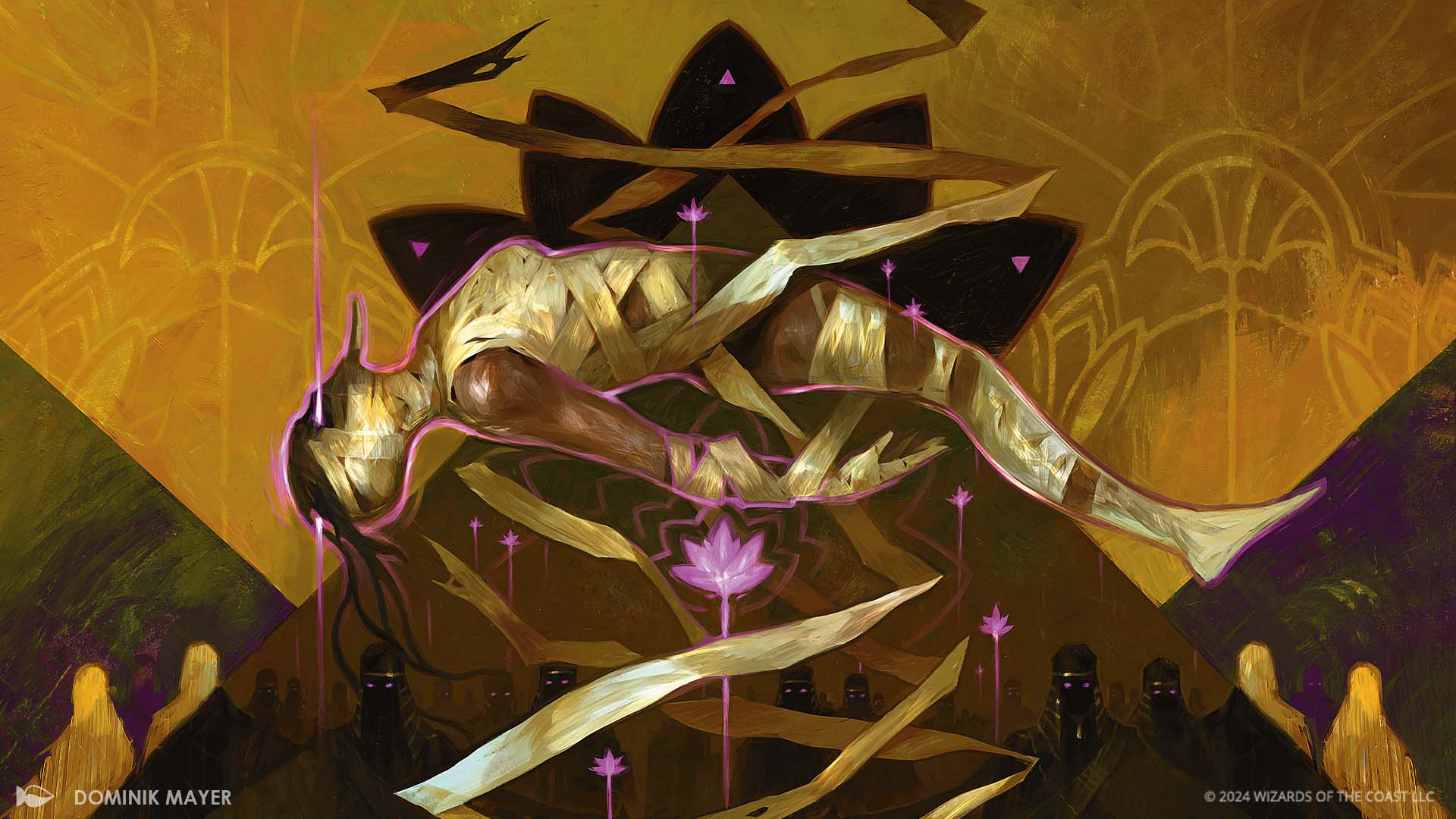
Meanwhile, Naktamun's undead faced a critical decision. The Phyrexian invasion saw the death of tens of thousands of Amonkheti. Newly risen under the Walking Curse, these fresh undead were not eager to submit to the old order of servile mummification. They recognized that their liberation was only possible at the beginning of reconstruction, when the living needed them the most. Older undead mummified under Bolas's reign (and after) took a longer view that, while the dead on Amonkhet—loyal and otherwise—outnumbered the living, using their numbers to capture the plane for themselves would not be a good long-term goal. The Walking Curse did not preserve the undead. They still decayed, albeit slowly. If the living were slaughtered and only the undead reigned, the plane would wither and die over time. The loyal undead, in short, needed the living to persist and grow for Amonkhet to have a future. As a group, the loyal undead in Naktamun approached the living defenders of the city with a plea and a promise: "Free us, and we will see Naktamun preserved." The living agreed, and together, the living and loyal undead came once more to the mutual defense of the city, holding back the tide of the wandering dead.
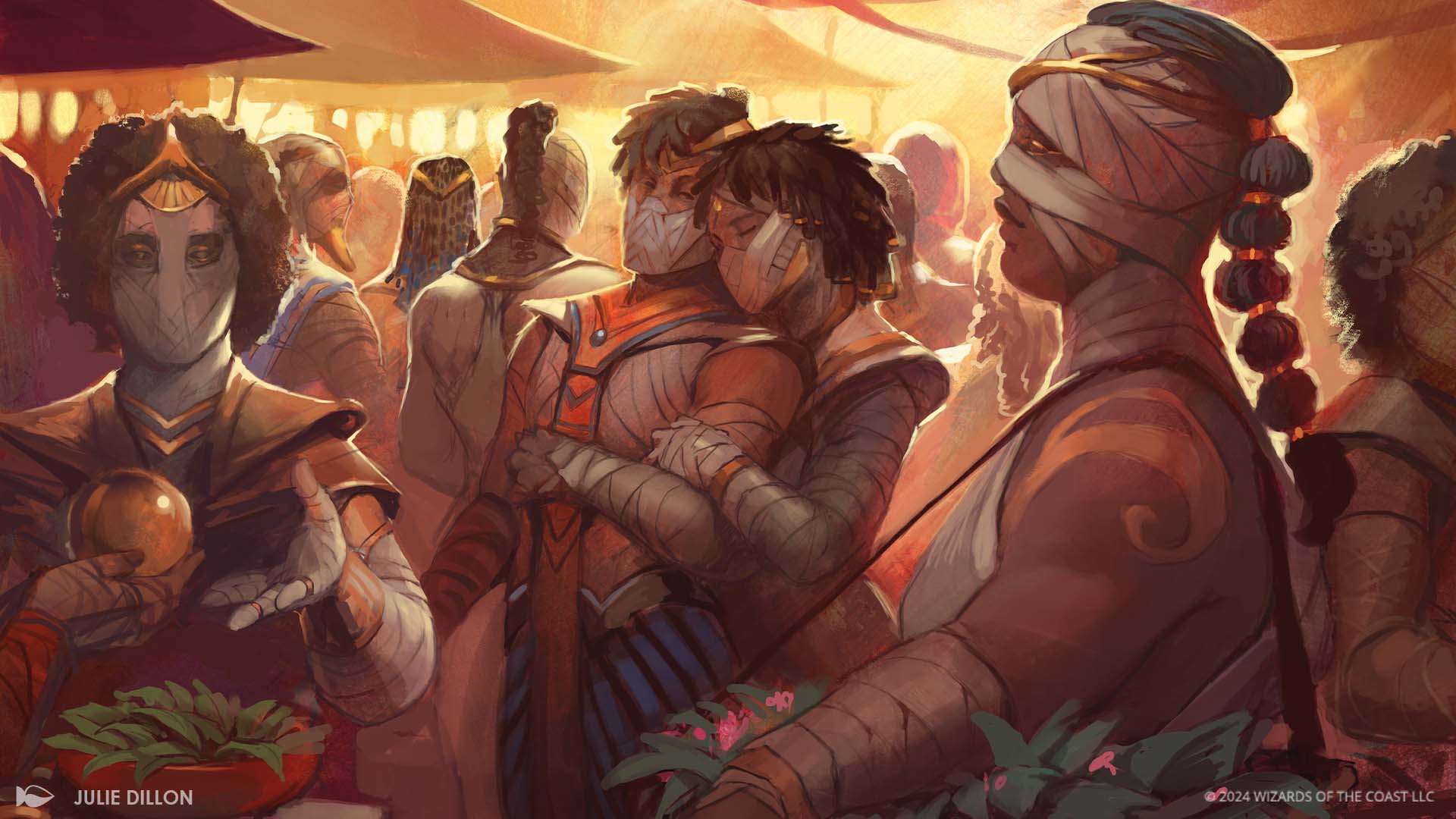
Now, Naktamun rebuilds from years of ruin, with both the living and the dead banding together to clear the streets, shore up the buildings that can be repaired, and remove structures that are too ruined to be salvageable. The core of the city has been cleared, but the work continues in outlying districts. All along the banks of the river Luxa, farmers dig new irrigation canals to channel the fresh water into their fields as green returns to Naktamun, and alongside the ringing of hammers and work songs are the calls of hawkers selling their harvests. Reconstruction will be a long process, but every day from that first dawn is a new day of freedom for a plane long in the shadow of tyrants.
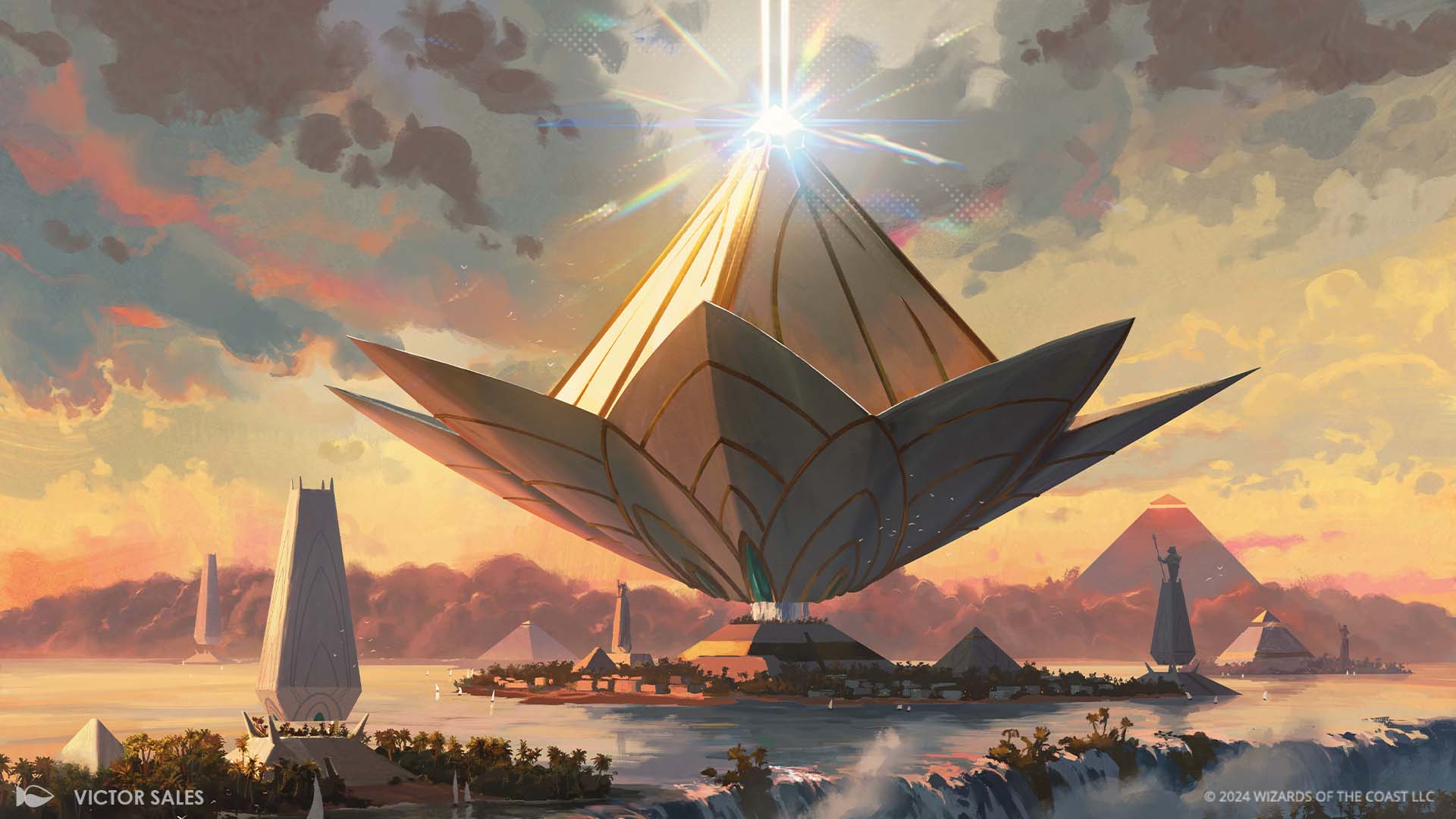
The New Gods of Amonkhet
One of the most consequential effects of the Phyrexian invasion was the fall of the Hekma, the magical barrier that sealed Naktamun off from the rest of the plane and protected it from outside enemies. Without a doubt, this is of concern to the living of Amonkhet. They are vulnerable, exposed to whatever hostile beast or army might wander out from the Broken Lands. At the same time, though, they are free—free to wander, to explore, to strike out from the relative safety of the city and discover the history and present condition of the plane they call home. This twin impulse—to guard the home and to explore the wild—is alive in the bodies of two new, risen deities that walk alongside Hazoret on Amonkhet: Ketramose, the lion of dawn, and Sab-Sunen, the new mother of the Luxa.
The Record of Days
During Bolas's reign, The Accounting of Hours was the primary religious text of the Amonkheti. Bolas hid Amonkhet's history from its people. In its place, the elder dragon constructed a nightmarish fantasy where he placed himself as God-Pharaoh, erecting monuments in his honor and even twisting the plane's pantheon to serve him. Upon the revelations of Bolas's lies, the faith of the people of Amonkhet was shattered. Nevertheless, faith remained and sought a home. Out from the terror of the Hour of Devastation and the Phyrexian invasion, the survivors on Amonkhet have begun to craft a new text, one that combines the yearning faith of the turbulent past with the guarded hope of better days to come. That text is The Record of Days, which charts a path toward a golden era that can only be built collectively. Three deities have been revealed in the text: Hazoret, who was known. Two others, Sab-Sunen and Ketramose, are new, having revealed themselves to the people of Amonkhet in the wake of the Phyrexian invasion.
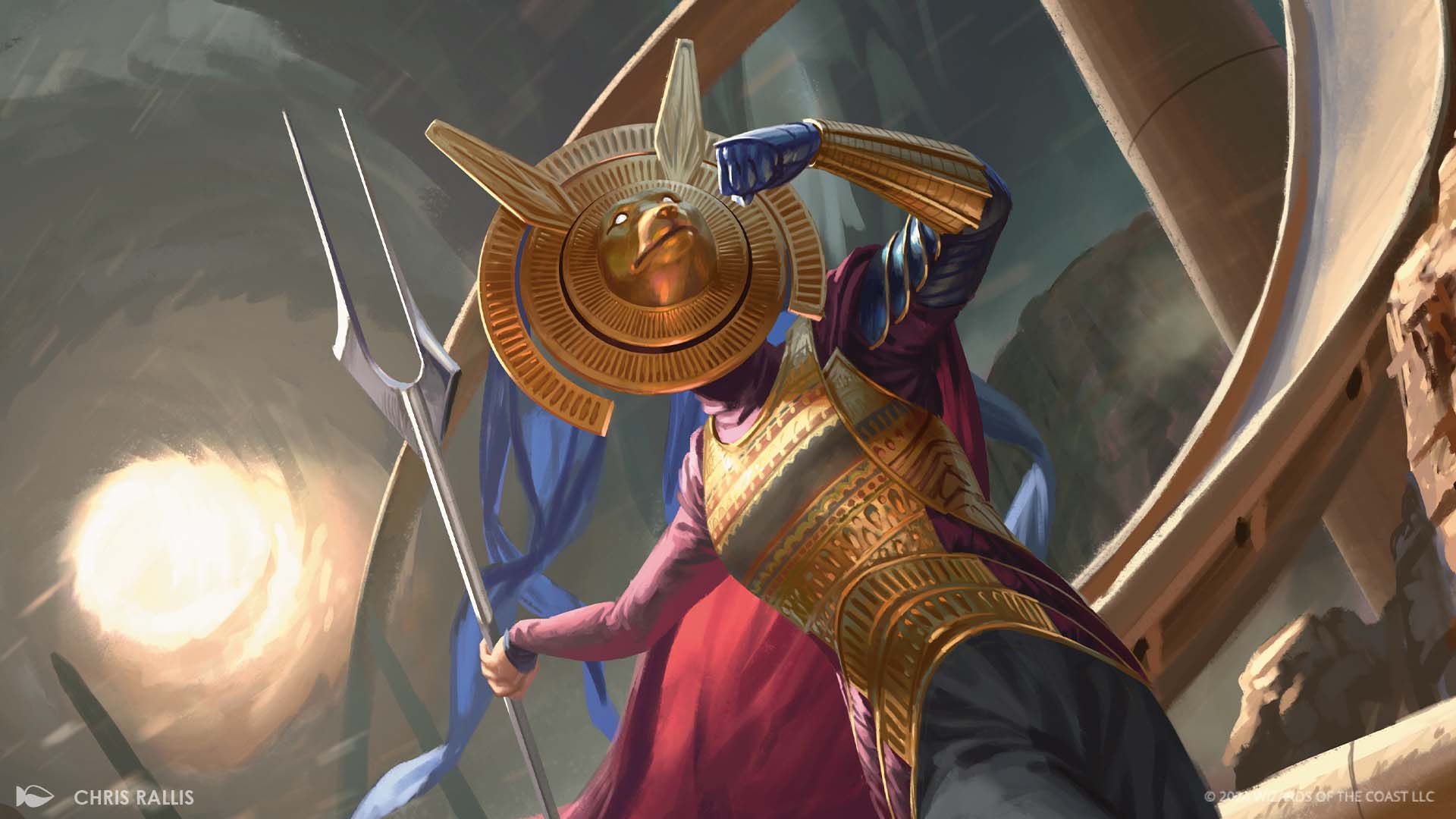
Hazoret maintains her austere distance from the people of Amonkhet, taking only small cadres of elite warriors out into the Broken Lands to scout parts of the plane unknown to them. Out there, they stalk the trails of the Locust God and the Scarab God, tracking rumors of a "Chitin Court" and the numberless "monarchs" who worship them. They send word back to Naktamun for reinforcements, depositing recovered artifacts of pre-Bolas Amonkhet and new charts of the Broken Lands. The people call her "Godseeker" and keep her and her cohort in reverent (if somewhat fearful) prayers.
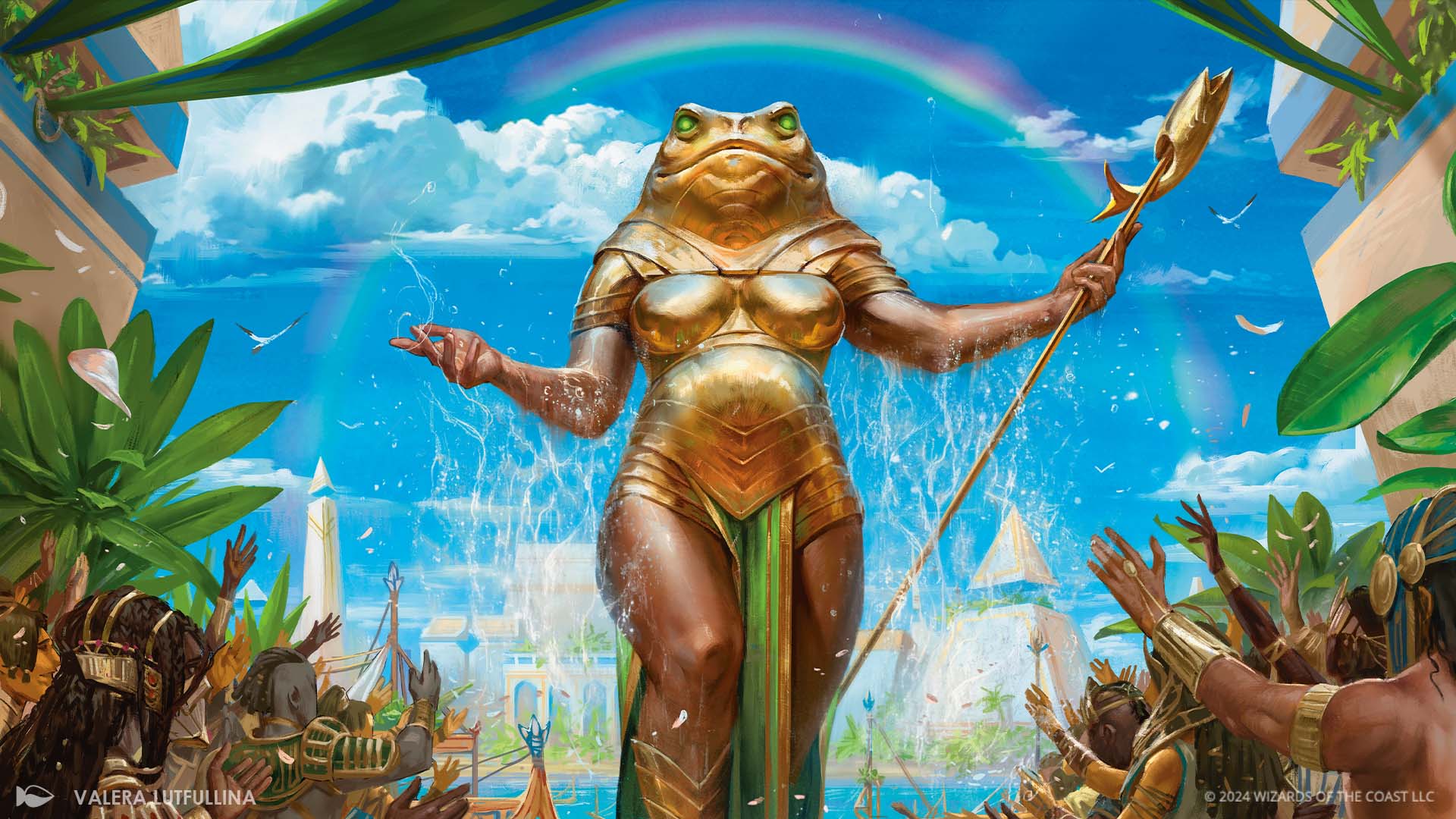
Sab-Sunen evidenced her presence before she revealed herself to the people of Amonkhet. The Luxa surged after the end of the Phyrexian invasion, flooding through Naktamun and washing away the blood, oil, and machine corpses. The city was cleansed. In the wake of the floods, came more rain, then frogs, and then the sun. Green life sprang up. Naktamun seemed refreshed, the river Luxa once more flowing steady, high, and clear, and the long-dry irrigation canals in the surrounding farmland once more carried water. The people celebrated, and at the height of their celebration and thanks, Sab-Sunen finally appeared. She takes the form of a human woman with a golden frog's head, carrying an icon of renewal.
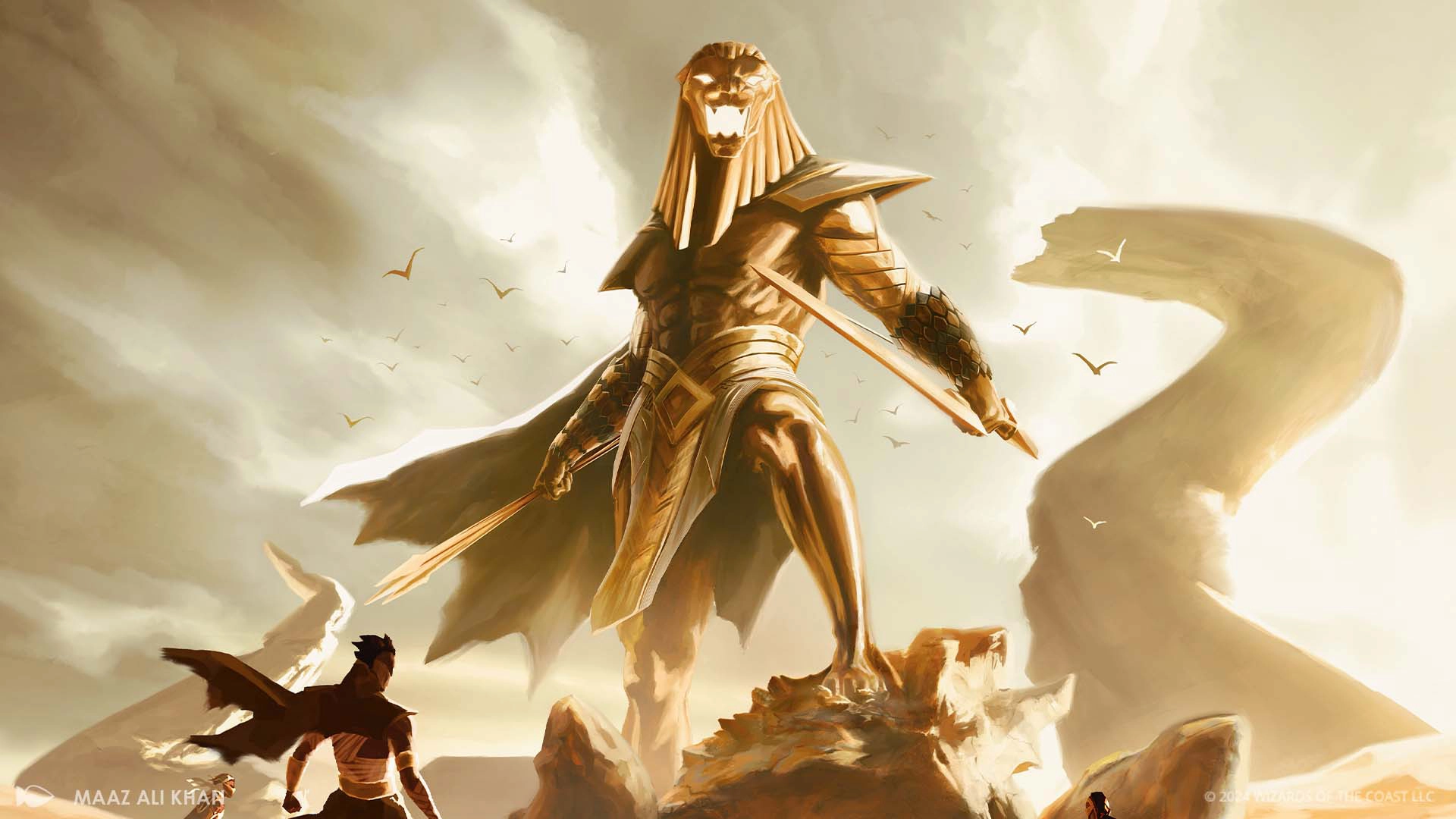
Ketramose is a young god born from the fierce determination of the living Amonkheti to survive and the undead Amonkheti to protect the living. He is the god of the breaking dawn and the future that awaits tomorrow, the living and the honored dead, hope, solidarity, endurance, and the peasantry. His birth followed the arrival of Sab-Sunen, born from the reeds that grew at the banks of the restored Luxa in Naktamun and rising from the sparkling water after the end of the Phyrexian invasion. He carries a bow that evokes Oketra's and takes the form of a muscled young warrior with a golden lion's head.
Orders of worship to Sab-Sunen and Ketramose have coalesced among the survivors on Amonkhet, who raise new temples in their honor. These deities are beloved by the people of Amonkhet, who know that this time their gods are finally theirs; they are not twisted or corrupted by an alien tyrant nor risen from death in a mockery of a mockery. These deities are the first gods of a new era who have burst from the yearning of the people of Amonkhet as they face the uncertain days ahead.
The Broken Lands, the Monarchs, and the Chitin Court
The Broken Lands
Outside of Naktamun lies the so-called Broken Lands, a blasted, sun-bleached ocean of dry sand, marching dunes, ruins, and the horrors, demons, and dead that lurk within. The living on Amonkhet were taught to fear this place, but after their years of wandering through them, they realized the truth: the Broken Lands are not to be feared, they are, like the rest of Amonkhet, meant to be healed. However, this is not to say that the Broken Lands aren't still deadly or that they do not still hide dangers, only that cringing from ghosts will not see Amonkhet reclaimed. Now is the time for bravery: led by their gods' champions, volunteers strike out from Naktamun in search of their lost kin, their ancestors, ruins that hold promise, and answers.
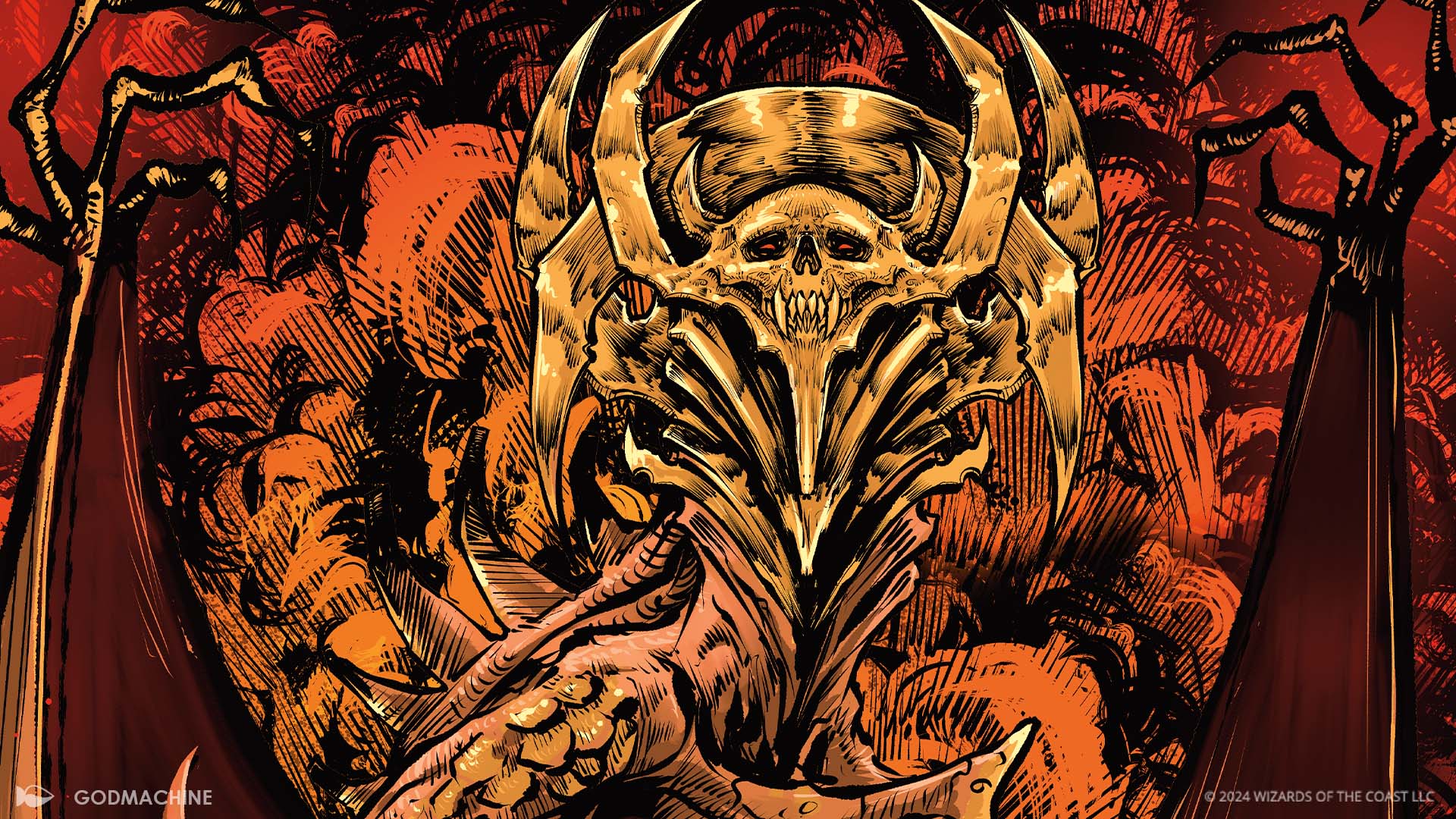
Haunted ruins lurk in the shifting sands of the Broken Lands. They are unquiet in the wake of Bolas's departure and the Phyrexian invasion. Tombs of long-dead kings and queens of Amonkhet, memorials to champions whose exploits bought them demigod status, and cities buried under sand, which became sepulcher-metropolises for the poor souls trapped within; the dead outnumber the living on Amonkhet, and everywhere the living venture they are reminded of this. Even small clutches of nomads encountered in the desert are close to the dead. It is not uncommon to find mixed groups of living and undead working and wandering together, the living cared for by the wandering dead, and the wandering dead revered by the grateful living.
The Monarchal Undead
Despite the teeming numbers of dead who do work to advance Naktamun's interest, most of the restless dead on Amonkhet do not care to work alongside the living. These are the monarchal dead, or monarchs, who hail from the high and early epochs of Bolas's reign and before, having languished in sealed tombs out in the Broken Lands for uncountable stretches of time.
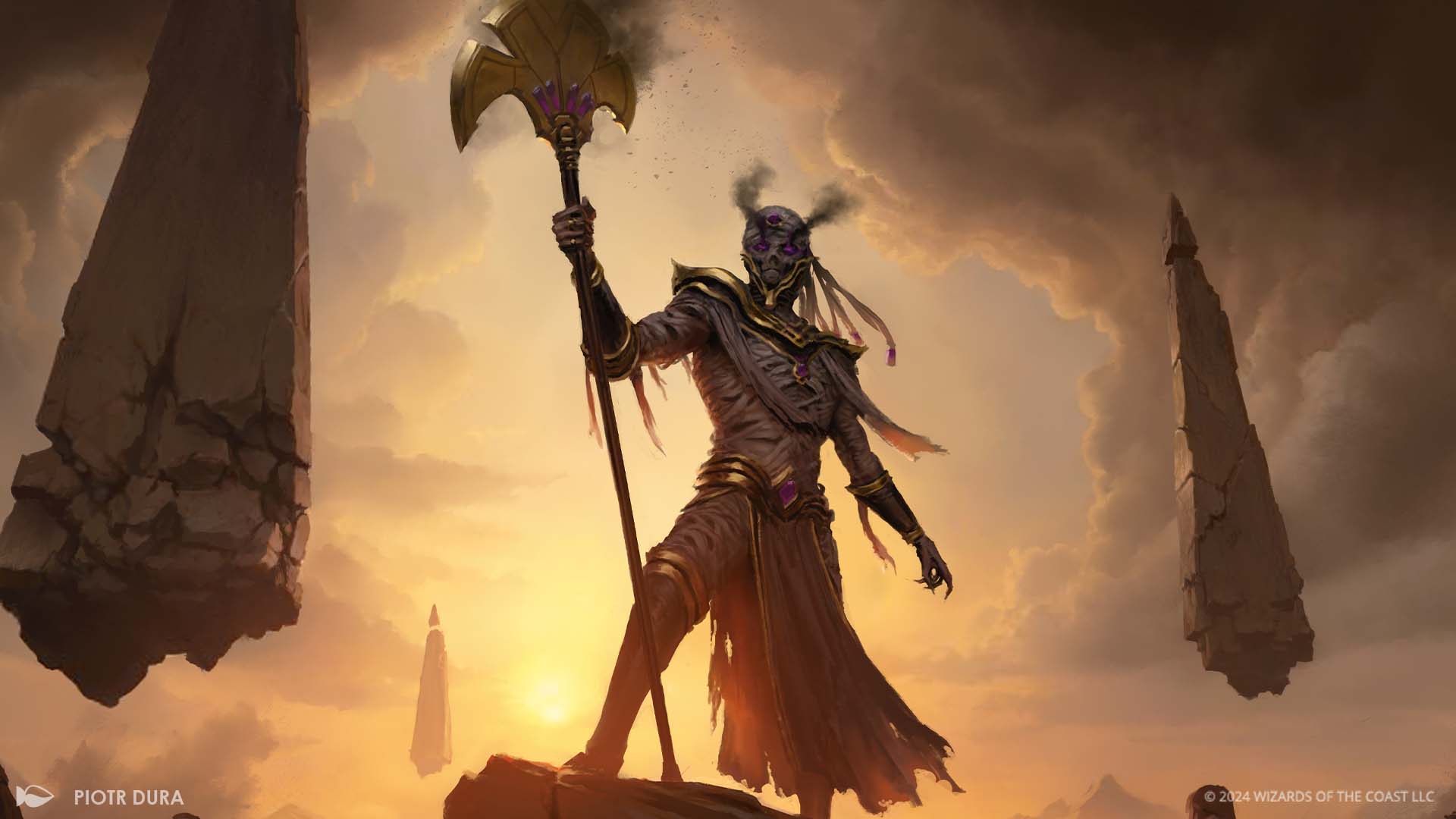
The monarchal dead are a vast and uncountable mix of jealous kings and queens and emperors from before Bolas's reign. Now they find their thrones crowded with dynastic descendants and rivals, the borders of their old lands lost under the sands of the Broken Lands, and a strange city—Naktamun—flourishing alongside the banks of the Luxa, the one holy constant on Amonkhet. Though their numbers dwarf the living population of Naktamun and the champions of Amonkhet, they have not yet been able to present a united front to threaten the city. These competing monarchs war between themselves across the Broken Lands, fighting to determine who amongst them is the de facto ruler of Amonkhet. The one constant they share—and most dangerous to the future of the new Amonkhet—is that nearly all of them swear loyalty to the Chitin Court.
The Chitin Court
The Locust God and the Scarab God remain on Amonkhet, reduced but no less divine, and are fed by cults that linger around remote oases and forgotten corners of Naktamun. They are the remaining two gods of the Chitin Court, who seek the remains of their long-dead siblings to revive. Their worshippers are the dead of the Bolas era, the few lazotep-enhanced Eternals that remain, and countless other undead who haunt the Broken Lands. The mightiest number of their faithful are the old monarchs, the dead who perished long before Bolas's reign, who look to these gods as the true gods of Amonkhet.
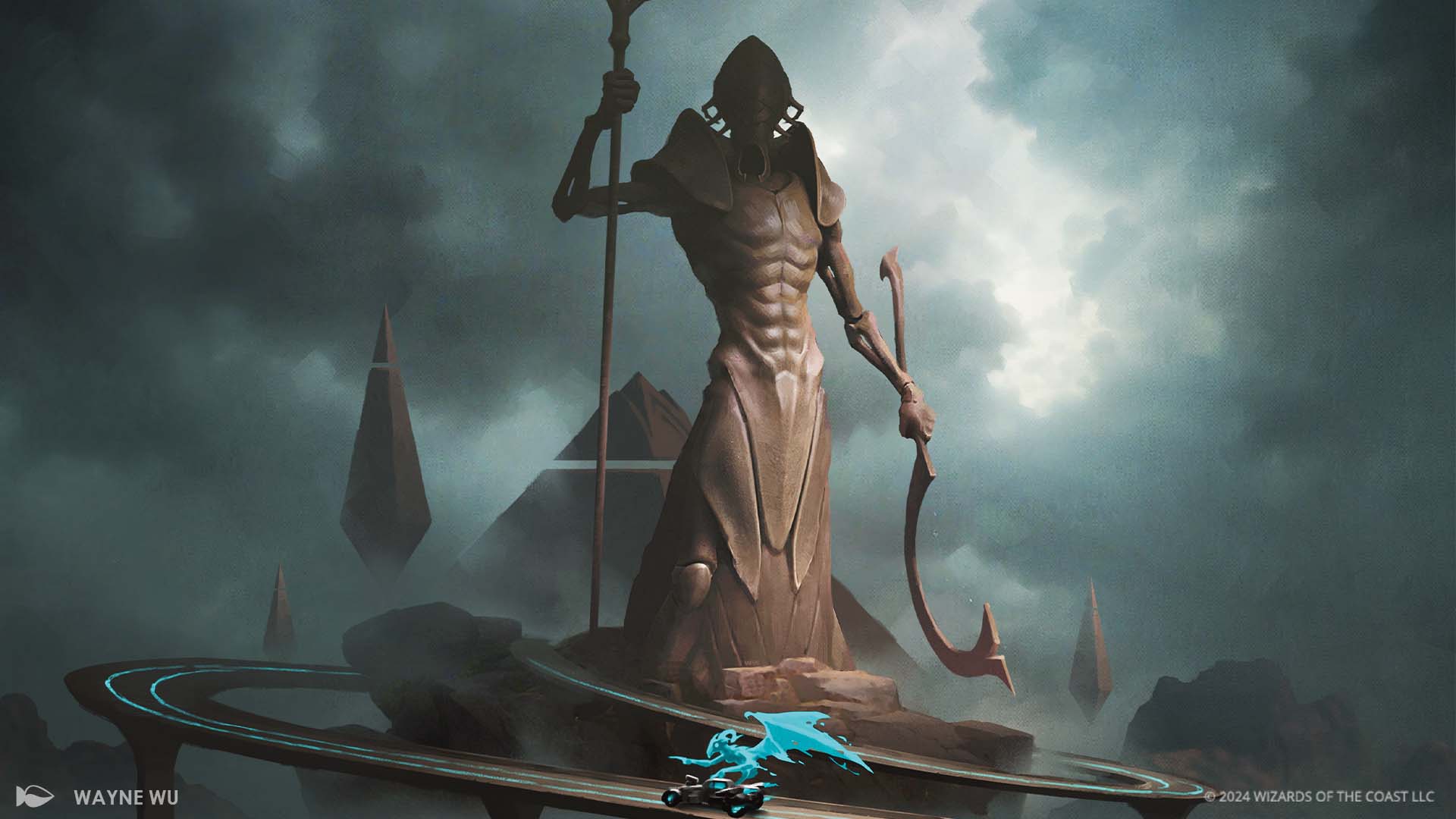
The monarchs of the Broken Lands and their followers are more than enough of a well for the gods of the Chitin Court to maintain their divinity but not enough to feed them back to full strength. Until then, the chitin gods wait and plot, honing their divine weapons and gathering new legions of the pre-Bolas dead. The new pantheon is an abomination to the Chitin Court: they see them as the creations of Bolas (whether literally, as in Hazoret's case, or born from a land tainted by him, as in Ketramose and Sab-Sunen's case), not true gods of Amonkhet. The Chitin Court's plans are long, as is their vision: they will collect their faithful, grow their orders, resuscitate the fallen brethren of the Chitin Court. Only then will they take back the plane they built.
Racers and citizens of Amonkhet whisper of dark signs in the Broken Lands that herald the approach of the Chitin Court. These include the shed skins of molting insects flowing like a dry river through the dunes, the towering silhouettes of the Locust God or the Scarab God seen in the swirling currents of mighty sandstorms, and empty tombs of ancient kings and emperors uncovered from the inside, their sarcophagi shattered and vacant, weapons racks disturbed. These signs are not yet enough to reach the ears of Naktamun's leaders and deities, but they will, in time.
The Curse of Wandering
On Amonkhet, unlike many planes, the barrier between life and death is slim and defined more by class than metaphysical or ontological factors. The dead walk, work, and serve alongside the living; once they were servile to them, enslaved by custom and practice in Nicol Bolas's Amonkhet. Now they are free and outnumber the living, but they are still Amonkheti. Though some might desire a state ruled by the dead, they understand that the future of the plane is only guaranteed if the living continue to produce successive generations. The Curse of Wandering, a fundamental and ancient magic that predates Bolas's reign, still afflicts Amonkhet. So long as it persists, the dead will walk until they are dust, and then they fade: only the living can grow, reproduce, and ensure the plane persists. The dead outnumber the living on Amonkhet, but they do not grow, they only decay; without the living, there will come a day when the last of the unliving crumble and Amonkhet dies.
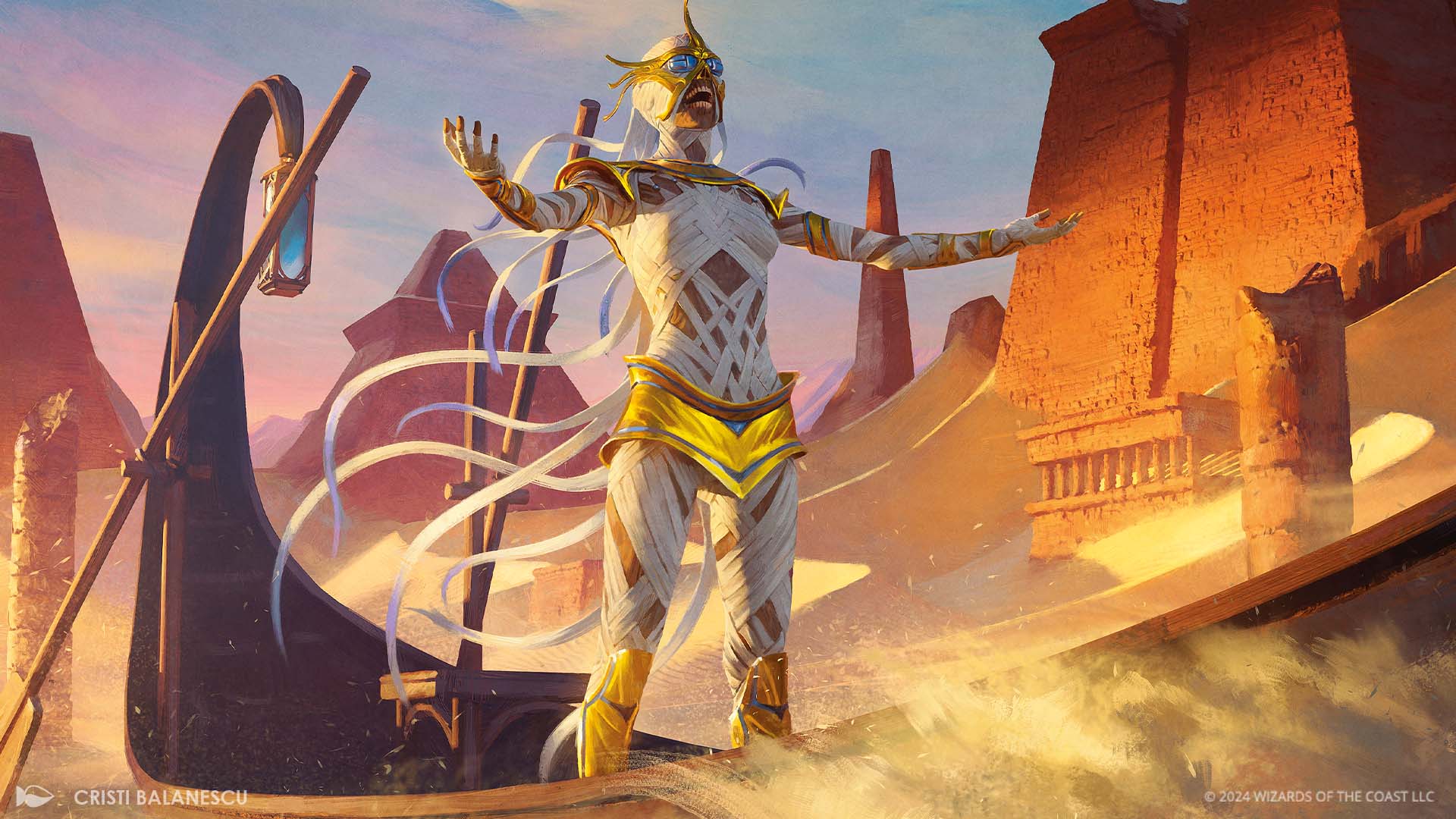
Amonkhet's greatest affliction, the Curse of the Wandering, proved to be its savior during the Phyrexian invasion. The Curse of the Wandering is an ancient magic from a lost era before Nicol Bolas's reign: The curse leads the dead not to rest but to remain undead. Until they are reduced to bone dust, the dead on Amonkhet live a second life. Alternately feared and subjugated by the living during the Bolas era, during the Phyrexian invasion, the dead surged to defend Amonkhet. These numbers included the forgotten dead from the Broken Lands who marched up in grand ranks from their buried tombs, led by the kings and queens and demigod heroes of Amonkhet's history before Bolas. Their phalanxes bolstered the ranks of the defenders of Naktamun, and together, they swept away the Halo-weakened Phyrexians.
In the year that followed, the living and the dead began their reconciliation. As Nicol Bolas once used the dead to raise new generations of the living in the wake of his mass slaughter, the dead of Amonkhet have begun to raise new generations of the living in the wake of unfathomable violence. However, this time, they raise them in the full light of knowledge. Unencumbered by Bolas's dictates, the dead of Amonkhet raise the orphaned young, tend the healing fields, and labor alongside the living few to ensure Amonkhet survives. In turn, the living view the dead as wise teachers, lingering ancestors, and stoic guardians without whom the plane would wither. Nevertheless, the living and the dead both must confront and overcome generations of prejudice and subjugation. The living humble themselves to the dead for putting them in fetters. The dead must learn to forgive. Both confront the truth: that they were made instruments of a dark being's will. Forgiveness for past injustices can account for that time. Now and for the future, any cruelties or grace will be their own.
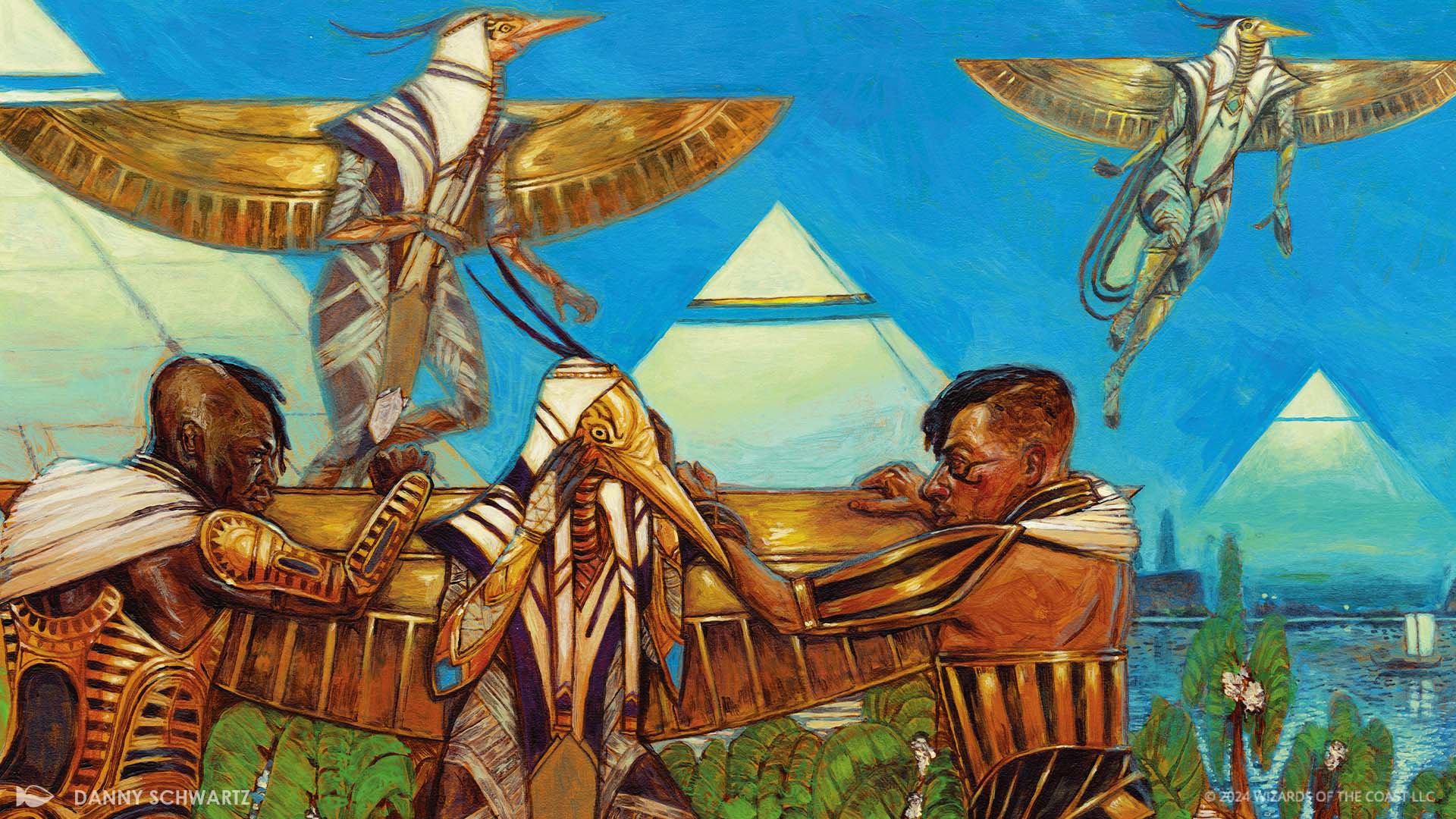
The process of reconciliation is uneven, involving fresh negotiations with each undead monarch, who all claim dominion over a world that is new to them. Some are friendly toward the living on Naktamun, having accepted that they hold the favor of the gods. Others, after the successful defense of the plane, have retreated with their hosts of undead warriors back to their ancient tombs to plot their own return to majesty and rule. These unsatisfied dead coalesce around the Tombs Before Time, a vast region of the Broken Lands far from Naktamun where ancient ruins emerge from the shifting sands. There, councils of long-dead kings and queens from the eras before Nicol Bolas sit on dusty thrones, arguing, maneuvering their armies, and plotting their return. They wage wars in the desert, throwing legions of skeletons against each other in bitter dynastic struggles.
Muraganda
Muraganda is a primordial plane rich with life and raw magic, though this was not always true: At some point in the distant past—outside of living memory but recorded in glyphs carved by the survivors and maintained by their descendants—a plane-spanning civilization that ruled over Muraganda discovered magic and then collapsed. The plane's moons shattered to pieces, and debris still falls onto the plane to this day.
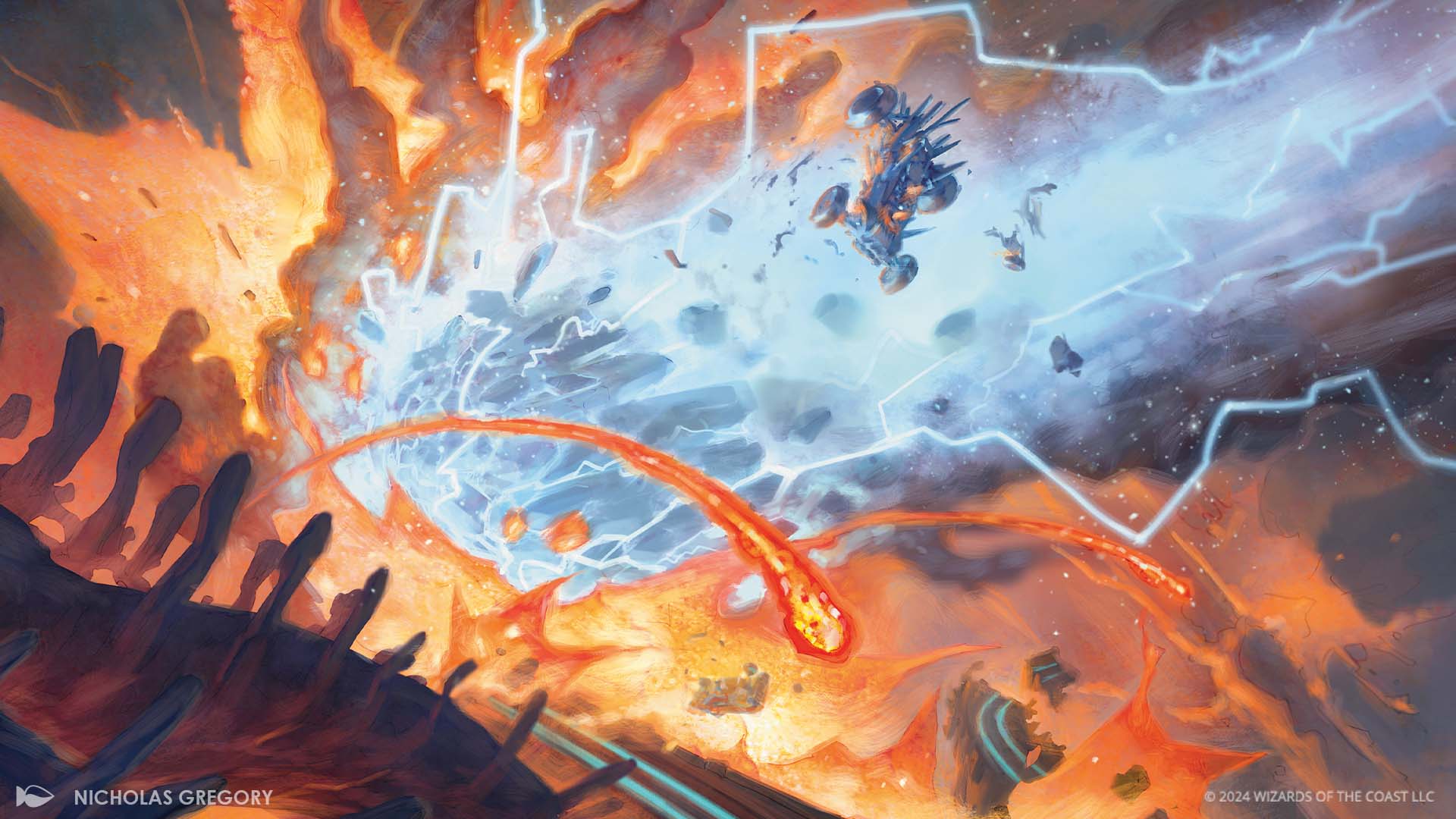
Muraganda changed over generations as the moon-strikes abated and survivors formed bands, tribes, and kingdoms. Because of the moon-strikes, the oozes, raw magic unleashed in the collapse, and many other after-effects of the initial calamity, Muraganda became how we see it today: a vibrant, mighty primordial plane of lush jungles, virulent life, hunted ruins, and raw, unforgiving landscapes. The echoes of the old civilization that once ruled the plane can be encountered in lonely ruins, but they are all but buried under the plane's new, primordial epoch, where new cultures and civilizations are learning once more how to use magic to its full power.
The Grand Prix on Muraganda
The Grand Prix stage across Muraganda is perhaps the most perilous that the racers will experience. The landscape features wild, evolving terrain rippling with exposed leylines, moonfalls and erupting volcanoes, titanic wildlife known and unknown, and local cultures whose curiosity is kinetic. The plane never accepted the race the way Amonkhet agreed to it and has responded as a body attacks an infection.
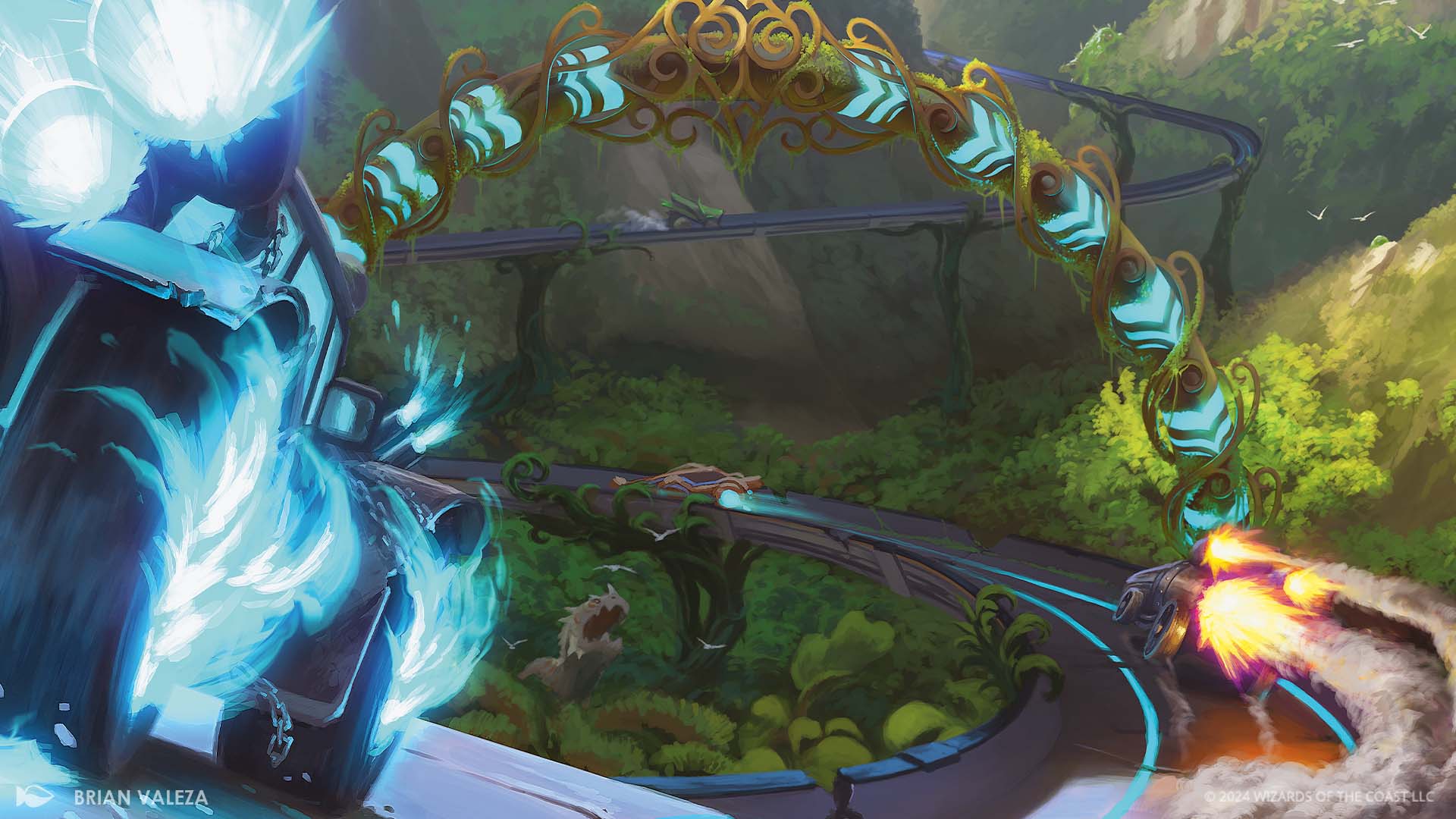
Advance teams from Avishkar were deployed to Muraganda a year before the beginning of the race. Split into four divisions (diplomatic, construction, maintenance, and security), this away corps has carved a path—sometimes literally—through Muraganda, upsetting the natural world. Though the Avishkari delegations were granted assurances by a ruling power, the Saurid Autocracy, that the land they built on was the proper place to do so, the race's security and maintenance teams have since discovered that the treaties their counterparts in diplomacy secured were only treaties signed with a map, not the terrain, the beasts, the oozes, or the myriad bands that live there. In fact, the Autocracy's agreements with Avishkar were a rather canny bit of political maneuvering. From their easements and agreements, the Autocracy advanced their own borders along the race route, secured infrastructural and technological exchanges, and assured themselves the prime position of "speaking" for the plane, though Avishkar has been making slow, steady diplomatic progress in negotiations with the most powerful mage circles recently and are sure to discover the particular wrinkles of their initial agreements.
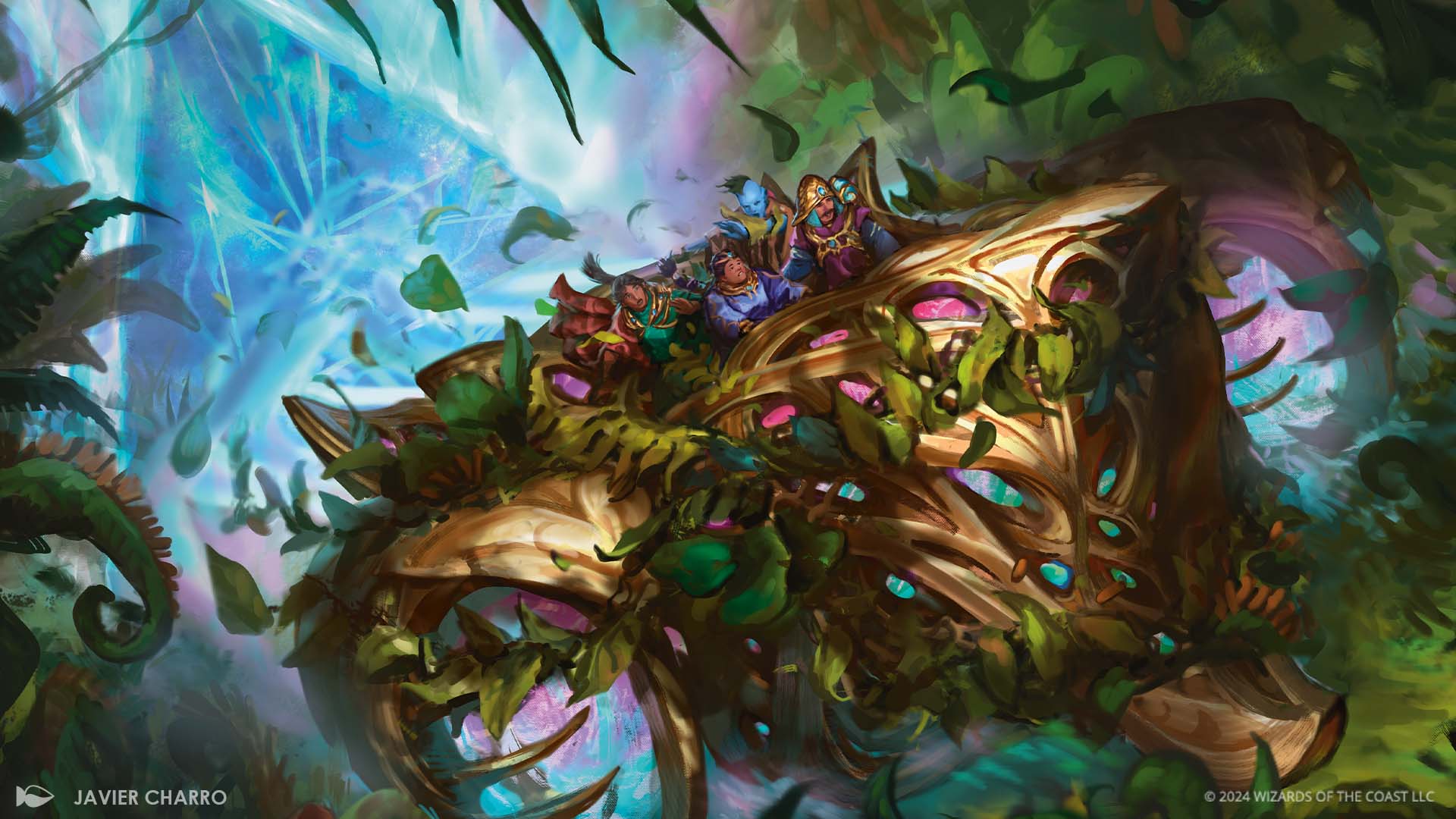
The race in Muraganda will take the teams through a rollicking tour of the plane's most beautiful and unforgiving environments. From perilous tracks suspended above coral pits and sky-scraping geysers to tight, forested corridors that punch through Muraganda's green walls of ancient jungle, the Muragandan portions of the Ghirapur Grand Prix will test its racers like never before. The haunted, vast sands of Amonkhet will seem like a dream to them. Here on Muraganda, they'll encounter walking-world oozes, dinosaurs warped by raw magics, and fearless raiders who never signed nor would agree to the treaty terms accepted by the Saurid Autocracy.
Muragandan Oozes
Oozes, alongside dinosaurs, are iconic beings on Muraganda and are embodied by one known, discrete individual being: the Mimeoplasm. Muragandan oozes are strange creatures of myriad suspected origins. Ley mages assume oozes to be a planar antibody of sorts, born from some deep place on Muraganda in response to the birth of magic on the plane. Scar witches claim oozes are moon-ruin entities who crashed down to the plane in the first moonfall and are refreshed with each subsequent impact. The saurids claim they are the living essence of their venerated ancestors, beings coalesced from the matter of the afterlife who carry in them the wisdom of past divine autarchs. The Telu-Set know oozes to be horrors and nightmares, insatiable creatures who steal children from their beds and swallow villages in slow-moving tides. The Fang Druids see them as walking cultivar engines, time capsule–like terrariums that carry inside them veritable vaults of curious, unique vegetation.
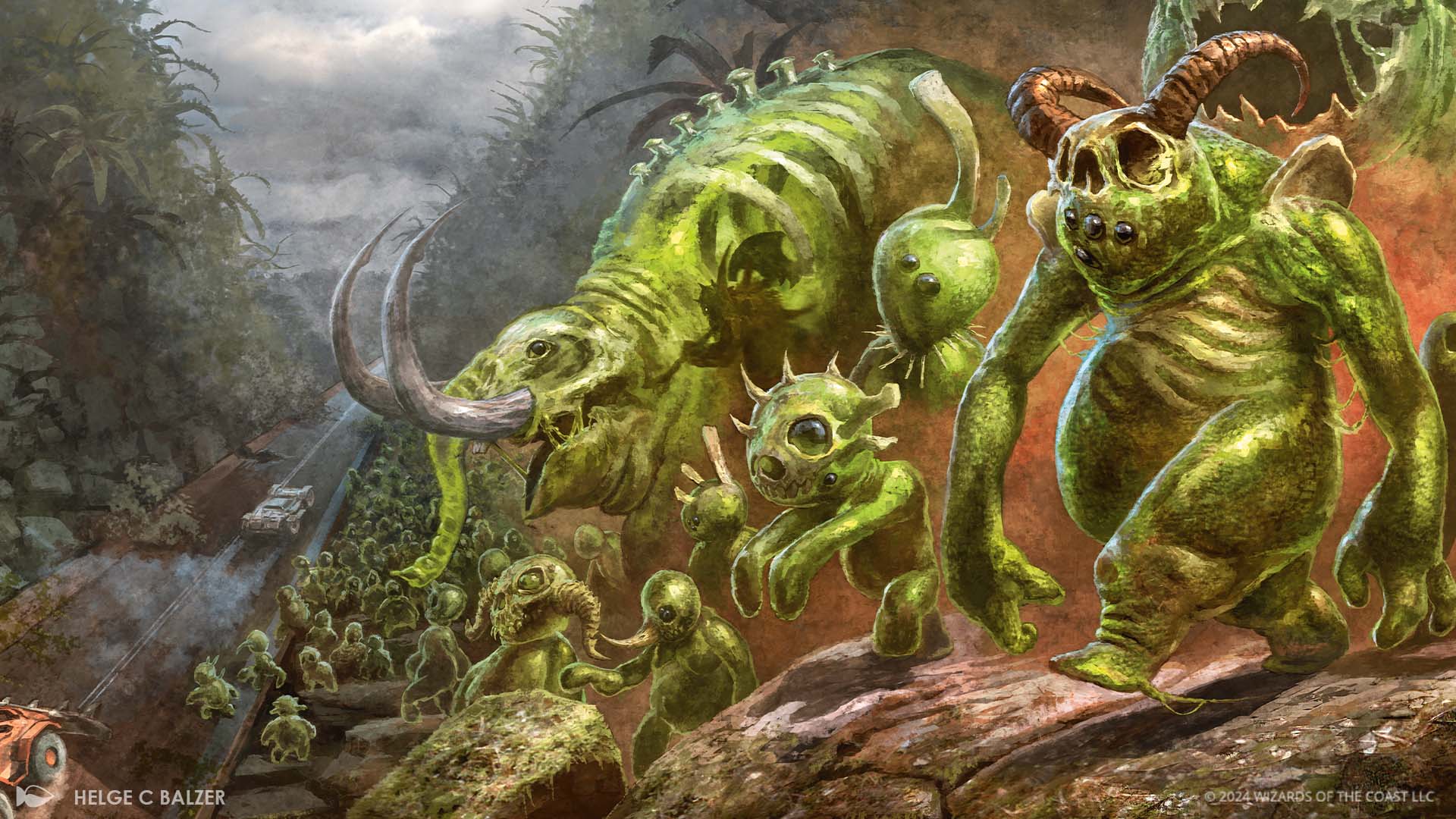
The origin of oozes was lost in the same fall that ended Muraganda's first world and propagated this new, vibrant plane. In the present day, they can be found in every biome on Muraganda, ranging in size from droplets to walking lakes. Likewise, their intelligence ranges: Oozes are containers that shape themselves to the memory of the beings they consume. The most intelligent among them are those who have consumed sentient beings—typically saurids via honored sacrifice or humans through misfortune—and display a rudimentary intelligence, echoing the being whose remains they process slowly and memories they absorb into their own being.
Encountered Peoples of Muraganda
Muraganda may be a primordial plane of raw life, but civilization grows there like anywhere else. On Muraganda, humanity rises, grasping at power for the first time since their ancestors began to conceive of magic and metal. Saurids put blade to jungle and carve a kingdom out of the wilderness. Other modes of organization—druidic hermitages, mage circles, deadgod city-cults, and endoalien planar circulatory-states—compete for power. Civilization on Muraganda is as primal, brutal, and winner-takes-all as the virulent life that characterizes the plane.
The Saurid Autocracy
The mightiest state on the plane is the Saurid Autocracy, a kingdom of saurids—humanoid dinosaurs—and their human subjects, who the saurids call softskins. Saurid society is stratified along rigid caste divisions, with the leading dynastic tyrant-families sitting atop a vast and byzantine social pyramid. The top of this pyramid is lavish and hedonistic, alien to the experience of the rest of saurid society by design. The middle is a noxious mix of bureaucrats, priests, and military commanders who, since the conclusion of the unification, squabble over internal politics, policing the lower classes, and the maintenance of their precious bureaucratic systems. The vast, seething base of this pyramid is composed of the myriad laboring classes of saurids; below them are the softskins, who are subcreatures to the tyrant lizards. All are subject to the absolute rule of the autarch, the sole leader of the Autocracy, who is revered as a divine monarch.
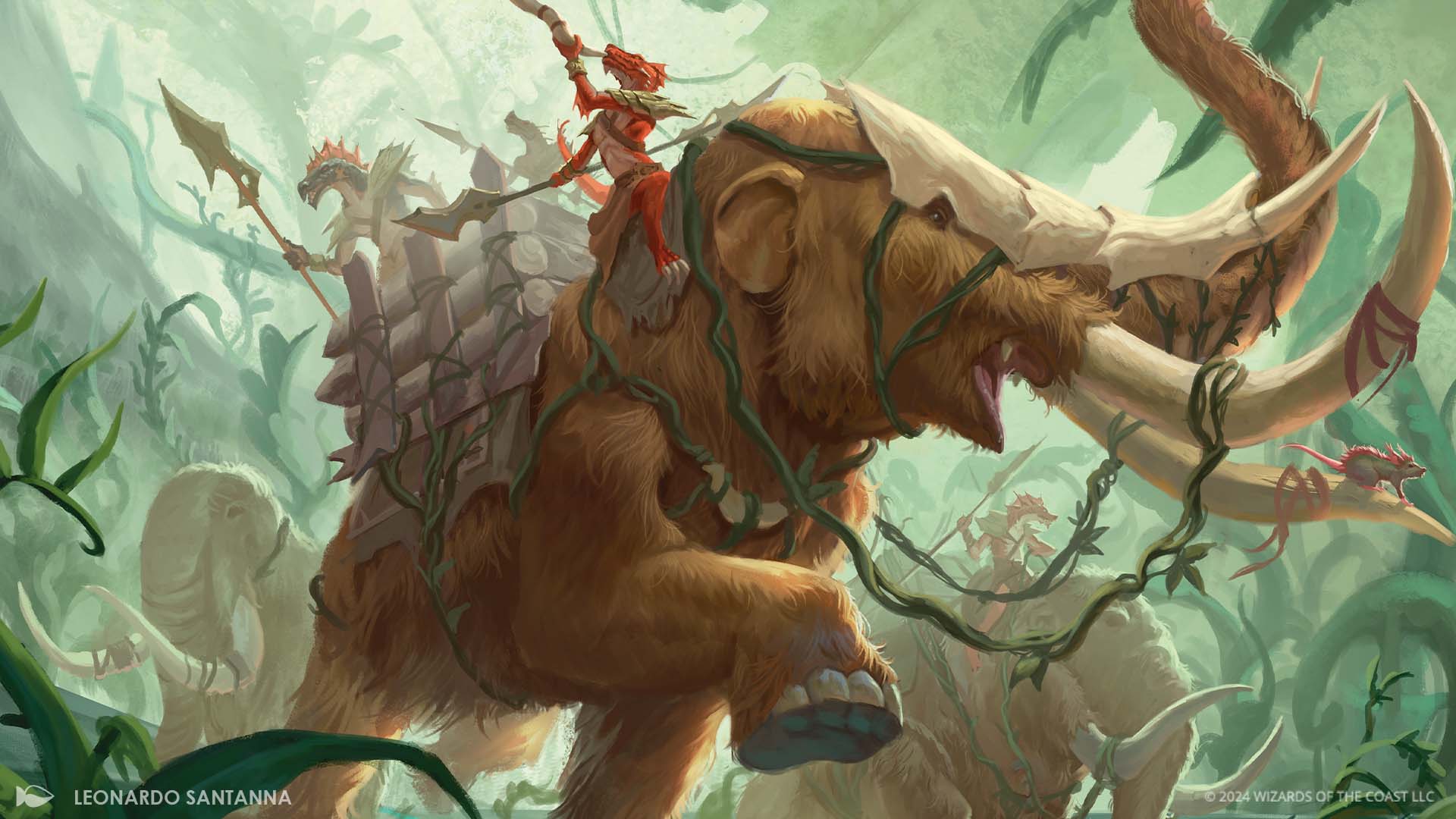
The Autocracy is capable of incredible feats of engineering and infrastructure, relative to other groups on Muraganda. They have already built vast temples inside their fortress city from which the plane's first paved roads extend out across their state. Arching irrigation canals feed water from alpine lakes, reservoirs, and rivers down into the saurid lands, where paddle-wheel engines power industrial pit mines and smelting factories. Saurids are obligated carnivores. Rather than fields and granaries, they maintain industrial pastures and abattoirs, smoking plants, and vast subterranean salting cellars. Humans under the Autocracy's dominion are allowed to grow small plots of communal vegetables and grains to satisfy their diets.
Saurids keep a close relationship with Muraganda's oozes, who they worship as the physical, supernatural remains of their departed ancestors. They regard the Mimeoplasm especially as a great figure if not a living god. Oozes contain and shape to the beings that they consume; upon their deaths (or deathbeds), saurids feed their revered elders to oozes so that they may live forever in the holy jelly.
The Fang Druids
Hidden among the dense jungles of Muraganda are the Fang Druids, a band-culture of great druidic apes and humans who are closely attuned to the heartbeat of the plane. The majority of Fang Druids are gorillas, though there are other great apes who they count among their numbers. Human druids are not common but enjoy the same rights and honor as their peers; unlike the Autocracy, there is no species hierarchy among the Fang Druids, only deference shown to wisdom and seniority. Apes and humans who do not follow the druidic path find their keep in the more mundane aspects of druidic life: farming, animal husbandry, the common defense of druidic circles, and so on.
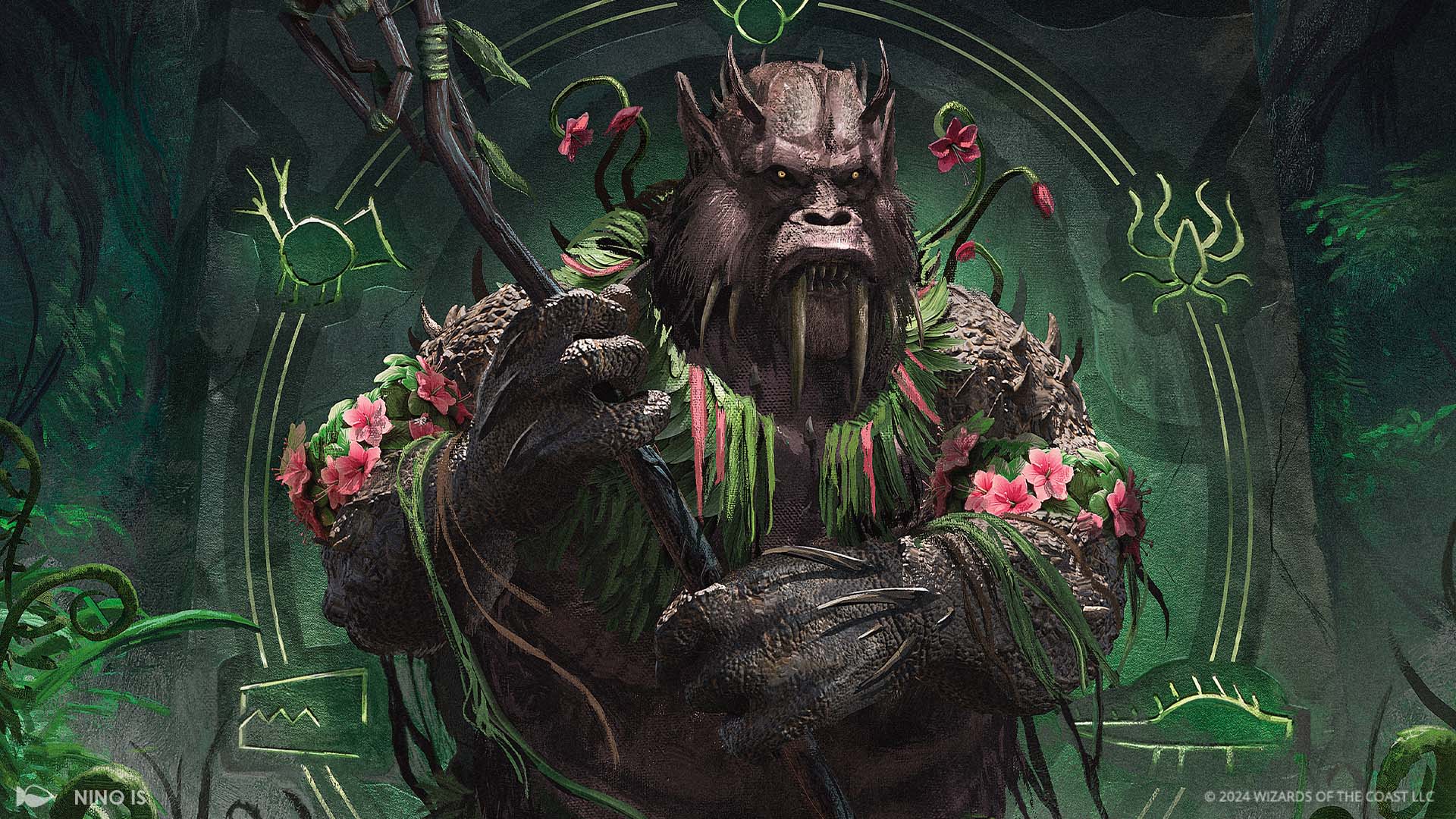
The Fang Druids are closely aligned with Muraganda's crater jungles. In Aetherdrift, we see the Fang Druids of the Green Hell, a band of dense jungle that grows among titanic craters created by ancient magic wars. The Fang Druids work to keep this a place of learning and growth against the incursion of the Grand Prix, where the weapons of both the new and the old are broken down to be understood—and better defended against.
The Telu-Set
At the borders of the Saurid Autocracy are the allied chiefdoms of the Telu-Set, five human clans who carve a life from the wild, harsh borderlands between the Autocracy and the ruin of Telu, the Telu-Set's magic-torn homeland from which they fled. The modern Telu-Set are a martial culture used to an austere existence, but they have not lost the riches or knowledge of their homeland: they are consummate riders, metalworkers, and weavers, who fashion impressive textiles from even the most depleted harvests. Telu-Set cavalry and magehunters are fierce fighters who have fought the Autocracy's border forces to a stalemate and regularly mount raids upon ley mage towers.
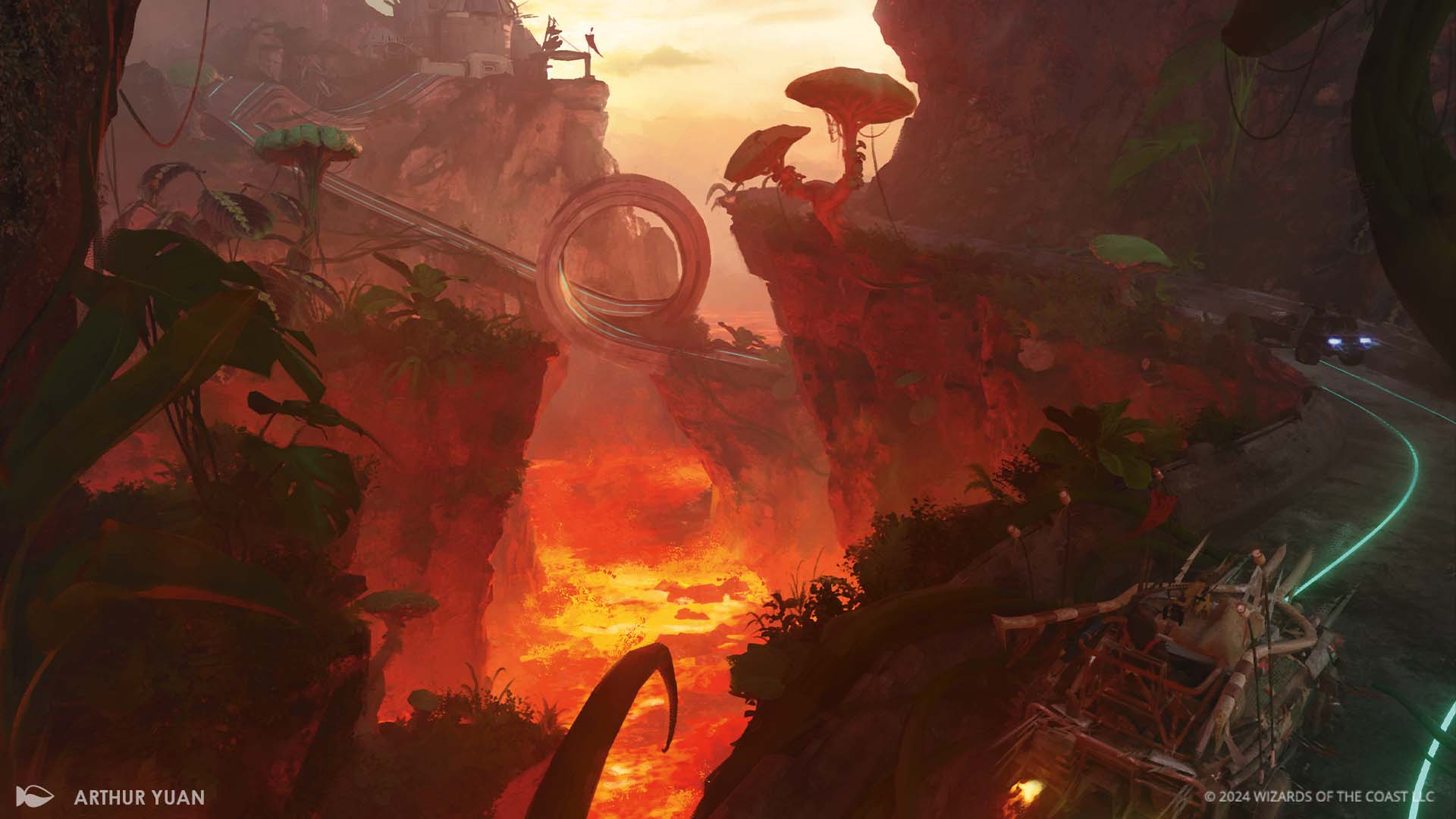
The Telu-Set chiefdoms are vehemently anti-magic, pointing back to the magical destruction of Telu by warring mages generations prior. They keep a strict, vigilant watch over their own population for budding magic tendencies; the only thaumaturgy allowed among the Telu-Set is that of null, or nullification magic, an oppressive form of anti-magic that some humans display an ability to cast at a young age or after the consumption of certain oozes.
Ley Mages and Glyphunters
Scattered throughout Muraganda are ley mages, mighty sorcerers who build attunement towers on and near leyline geysers, studying and feeding on the raw magic that erupts from them. Ley mages organize in small circles of magic users and their families, retinues, and students. The mages seek out glyphs of power that are scattered across Muraganda, mighty leyline geysers, and those who are born with the power, skill, and aptitude to tap into and control magic.
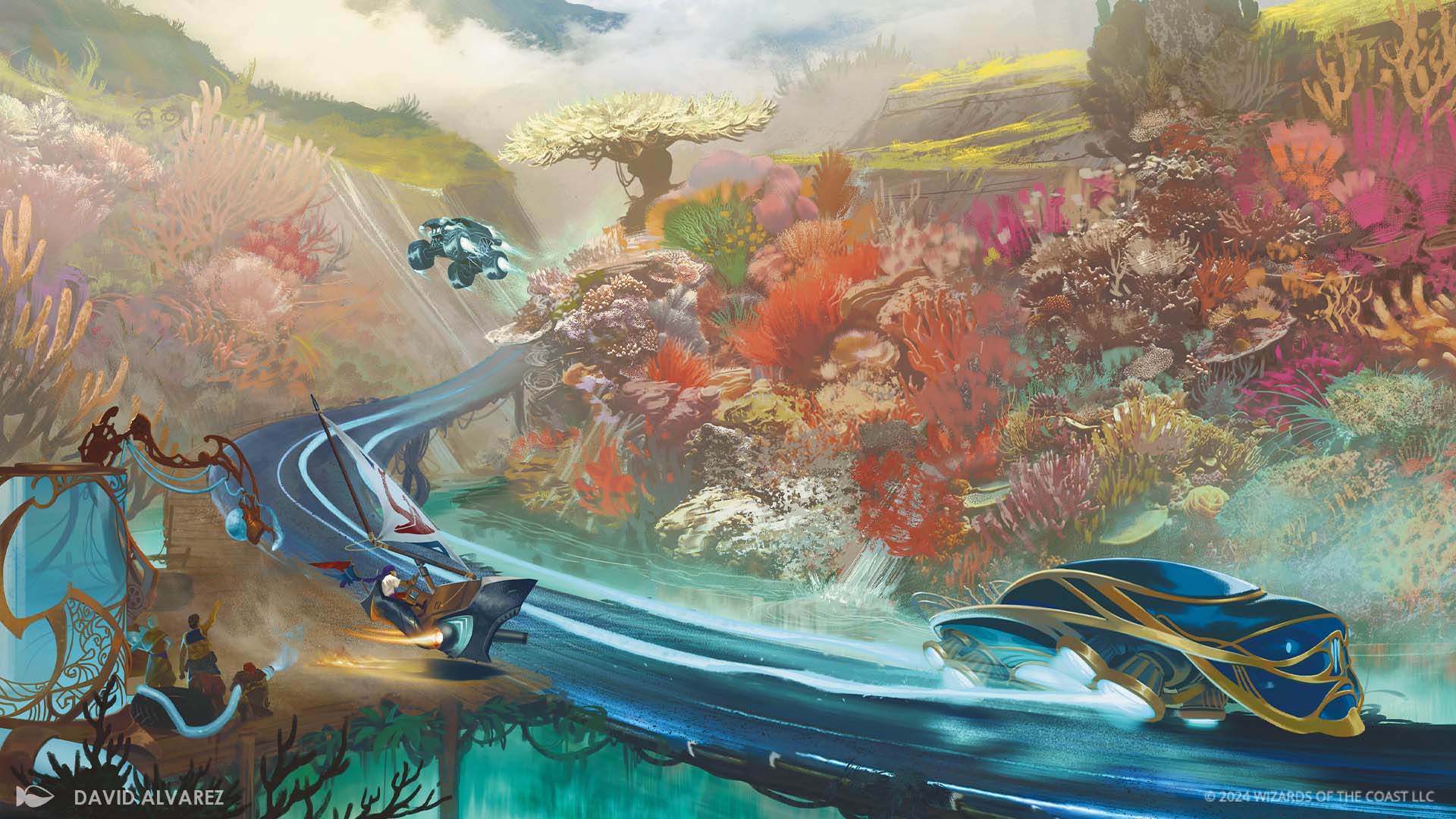
Ley mages see a potential for vast knowledge in the leylines and methods by which one can gain understanding of the physical and metaphysical world. On Muraganda, they are the closest beings to understanding leylines, the concept of mana, and contacting the plane's world soul. However, save for their annual symposiums, they rarely gather or share information and knowledge. Ley mages are rarely charitable with those they count as rivals, and there are no greater rivals to ley mages than other mages and rival circles.
Ley mages are served by glyphunters: brave, desperate rangers from the towns and villages around mage towers who volunteer to venture out into the mana-burnt wilds and moonfall fields, seeking artifacts of the old, lost world.
Scar Witches
Highly individual, territorial, and ruthless, scar witches can be found in and around Galadak's Scar, a dark and terribly cold field of craters where the first moonfalls hit Muraganda. These pale, wraith-like beings are dying memories—the near-faded ghosts of the Muraganda that was. They cling to the remains of their world, jealously guarding the ruins with one eye on the sky, looking to the heavens for sign of moonfall that might bring them more memories of the world that was.
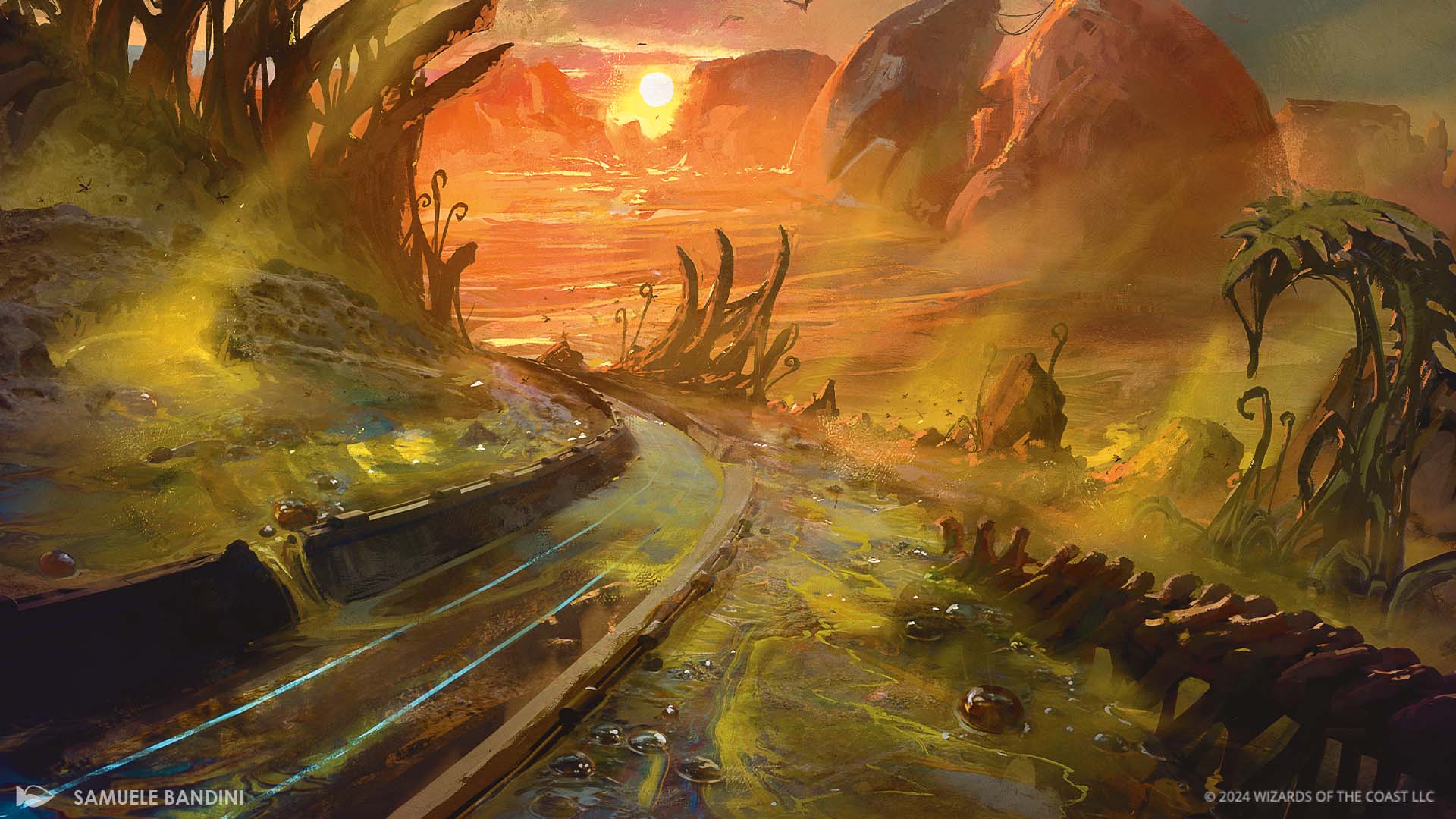
To better control their magic, scar witches make a contract with a veiled walker or a deadgod who can then act as their magic patron and guide them in the proper and safe methods by which they can tap into Muraganda's raw magic. These tall, solitary, wandering horrors travel the boundaries of life and death, hovering in the dim and dying zone where night eats the day. Veiled walkers and deadgods are proceeded by the sound of chimes. Scar witches drape themselves in veils and bells to mimic the appearance of their patrons.
The Dawnchaser Pilgrims
The Dawnchaser Pilgrims and their solar effigies mark the beginning of non-animistic, monotheistic religion on Muraganda. This order of gold-clad nomads carries their altars with them on large, wheeled carts. They walk across Muraganda following the ancient roads, turning from shadow to seek truth in the dawn hours where night turns to morning.
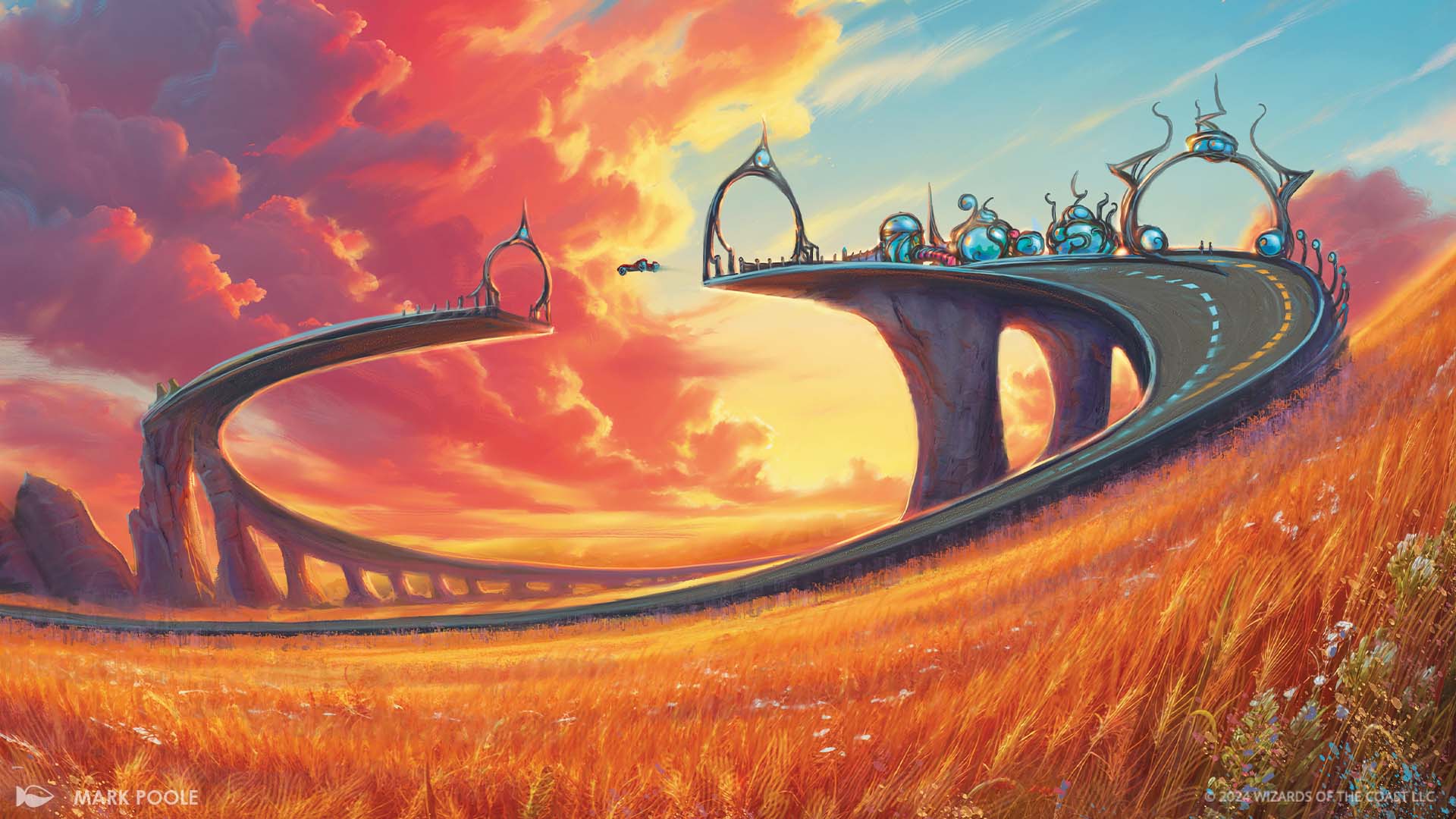
The Dawnchaser Pilgrims keep two magical sites on opposite sides of Muraganda—the Summer City and the Winter City—where they stop to refill their dawnlamps, hone their sundial weapons, and commune with the steady dawn. Twice a year at the proper time, they gather at these cities and hold week-long celebrations to venerate the sun.
The Wandering Scribes
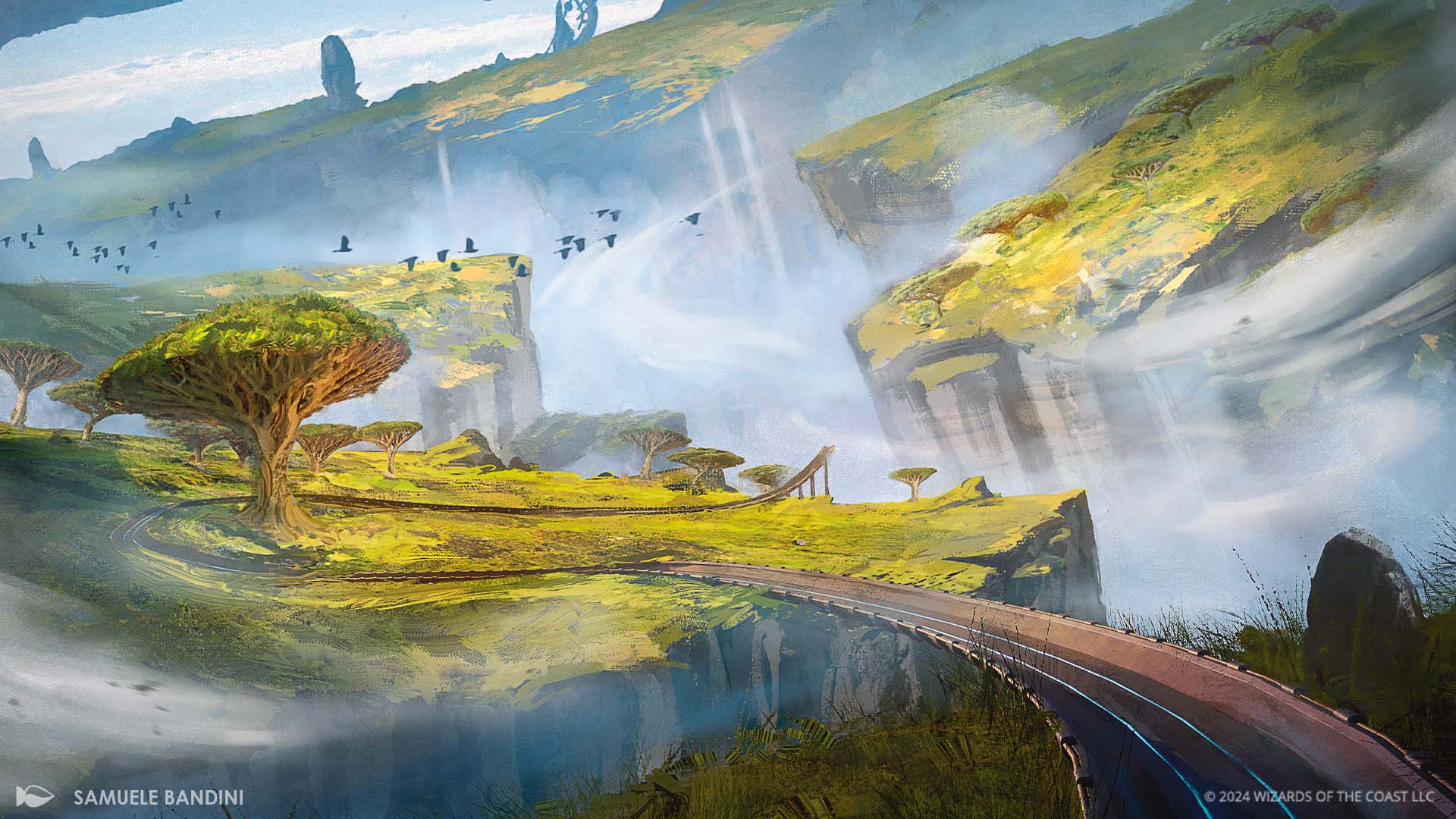
The monastic order of the Wandering Scribes has developed a new written language, practices of record-keeping, and the technology to create a fungible, lightweight medium to store their words: paper. The scribes are often encountered in the world as mercenary record-keepers, offering their contracted services to kings, chieftains, high priests, mages, and merchants.
Muragandan Raiders
After the decision was made to send the Grand Prix through Muraganda and the first advance teams arrived via the stable Amonkhet-Muraganda Omenpath, the civilizations of the primordial plane responded. Some were curious, as many circles of ley mages reached out to the delegations from Ghirapur, eager to learn more of the Multiverse (and grow their own strength). However, most responded as they have learned to face unknown or uncertain things on their homeworld: with swords drawn and clad in armor.
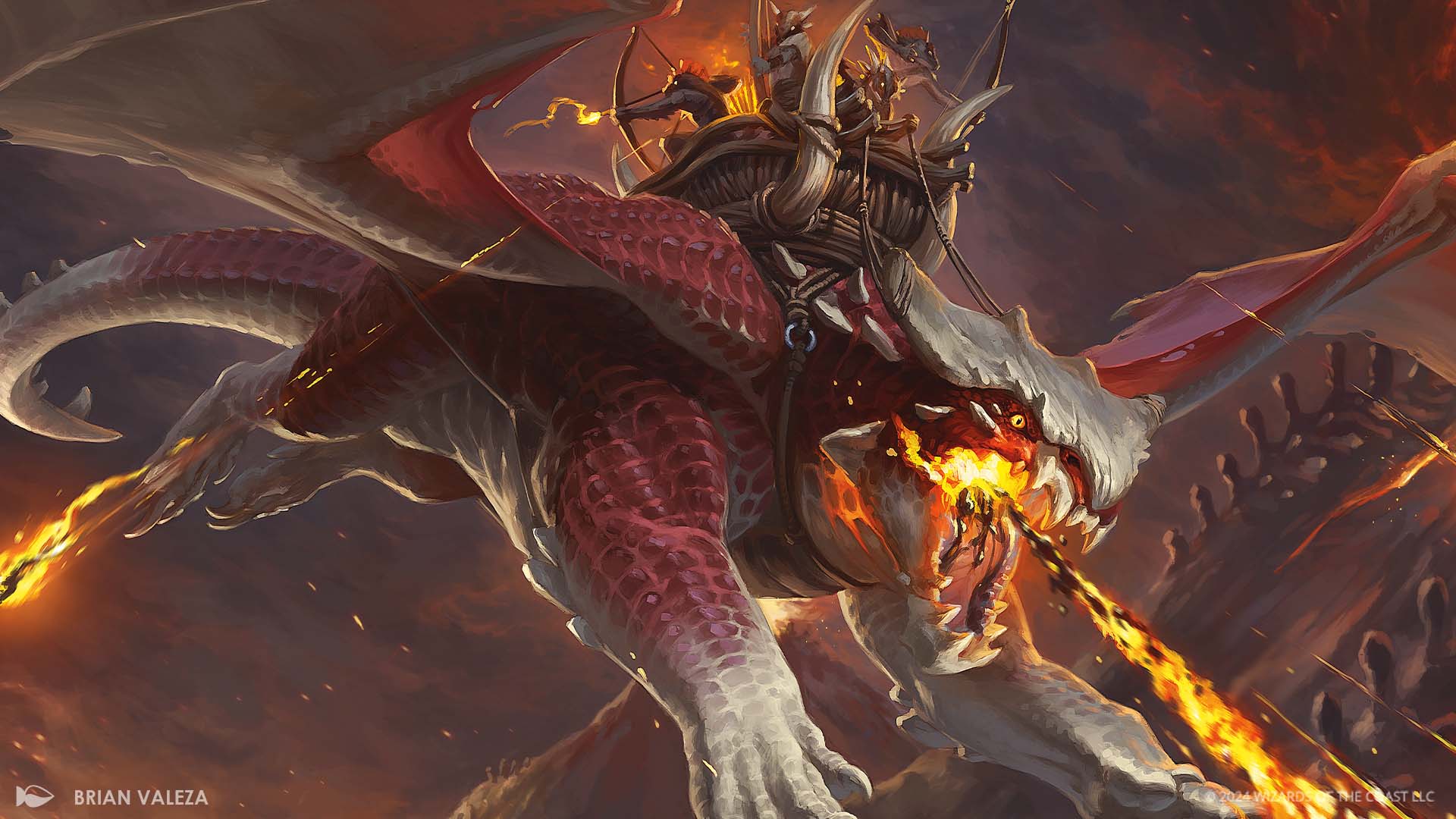
Raiders on Muraganda tend to be affiliated with the Telu-Set or the Saurid Autocracy. Telu-Set raiders are hardened magehunters, null-mages, and the mundane warriors in their employ; professionals, as much as the Telu-Set have professional soldiers. Raiders from the Autocracy are typically composed of mixed units of immortal, shedskin, and softskin cavalry who ride armored flatback raptors and larger beasts. Neither group is faster in an endurance race than the teams participating in the Grand Prix, so they resort to stalking out the perfect chokepoints on the course, setting up traps and ambushes and aiming to take advantage of the chaos when the race comes through. They both share the goal of preventing further incursion by the Grand Prix into their lands, only differing in the specific outcome they seek. The Telu-Set wish to kill any magic users, while the Autocracy merely seeks to capture and reverse-engineer the wonderous technology the Grand Prix brings.
You've met the racers, learned the history of the Grand Prix, and know the track they'll be racing on. Now, prepare for the competition of a lifetime as we take off in Aetherdrift early next year.
Find out who wins when Aetherdrift's story starts on January 13, 2025, and chase a victory of your own when the set releases on February 14, 2025. You can preorder Aetherdrift now your local game store, online retailers like Amazon, and elsewhere Magic products are sold.



